There is a guaranteed method for making even the most peaceful of restorers hostile: uttering the phrase “restore to ancient splendor” in his presence. Emanuela Daffra, superintendent of the Opificio delle Pietre Dure, is explaining this to us in front of a panel by Giovanni Bellini that has been under the care of professionals working here, in the institute’s laboratories, an internationally renowned center of excellence in the field of restoration, for four years. It is a marvelous altarpiece that Bellini painted in the early 1610s for the church of Santa Maria degli Angeli in Murano, only to be transferred, after the Napoleonic suppressions, to the church of San Pietro Martire, also in Murano. The very high humidity on the island, combined with not exactly excellent preparation (indeed: the craftsman who prepared the binder in Bellini certainly did not distinguish himself by doing a good job), ended up ruining the work. And now, this Madonna in Glory is lying on its side, work nearly completed, waiting for word of where it will be placed when it leaves the Opificio. She will not be able to return inside her church, because the building cannot provide the microclimatic conditions necessary to adequately preserve the painting. Unless, of course, it is boxed up inside a cyclopean-sized climabox , a solution that, however, seems unlikely, to be fair. Until a suitable accommodation is found for it, therefore, it will remain here. In the company of a professional humidifier that will create a suitable atmosphere around her.
The director points out to us the boarding that moisture has caused the wood of the table to take: when the table was standing on the altar we did not notice it (and, to tell the truth, we do not even see it here if we stand in front of it), but now that it is lying in front of us on the side we can clearly see how Bellini’s work has become a convex surface. And that is how it will remain forever. “If someone tried to straighten it,” says Emanuela Daffra, “the color would no longer have a surface to rest on. The more you straighten the boards, the worse it gets. Keeping the curvature means keeping the surface that the color has adapted to.” And then he points out the cloak that wraps around St. John the Baptist and partially covers his tunic. The lower flap has completely lost the transparent veiling typical of Bellini’s work: one has to imagine it darker, with the folds of the drapery, with the modulations of light offering to the relative those splendid iridescences seen in other, less damaged areas of the painting.
The scars, somehow, can be fixed. One can also give the work a legibility close, perhaps even entirely adherent, to that which it may have had at the time it was executed. And still, any intervention will always, inexorably, go on to produce, at the very least, chemical and physical alterations to the painting, even if imperceptible to the public eye. Then, panels such as Bellini’s Madonna in Glory will always remain weak, will always have problems, especially if the most suitable conditions for their maintenance are not produced. So they will always need care. That is why it makes no sense to say that a restoration “restores the work to its former glory.” Antonio Paolucci detested this expression: he thought it proper to bad journalists. And while for the public it may be indicative of the lexical desertification advancing on the pages of newspapers, for a restorer it is nothing but a mistake. Perhaps the most apt example, though a little crude and licentious, is that of plastic surgery on a person: it may make wrinkles disappear, but it does not bring back the age of the person undergoing it. Unlike plastic surgery, however, restoration also and above all serves to extend the life of the work, trying to create acceptable conditions for it to live as long as possible. Giovanni Urbani, for example, used to say that with restoration one delays the ruin of the work. Or, to recall Cesare Brandi’s well-known definition, it can be said that “restoration constitutes the methodological moment of recognizing the work of art, in its physical consistency and in its dual aesthetic and historical polarity, with a view to its transmission to the future.”
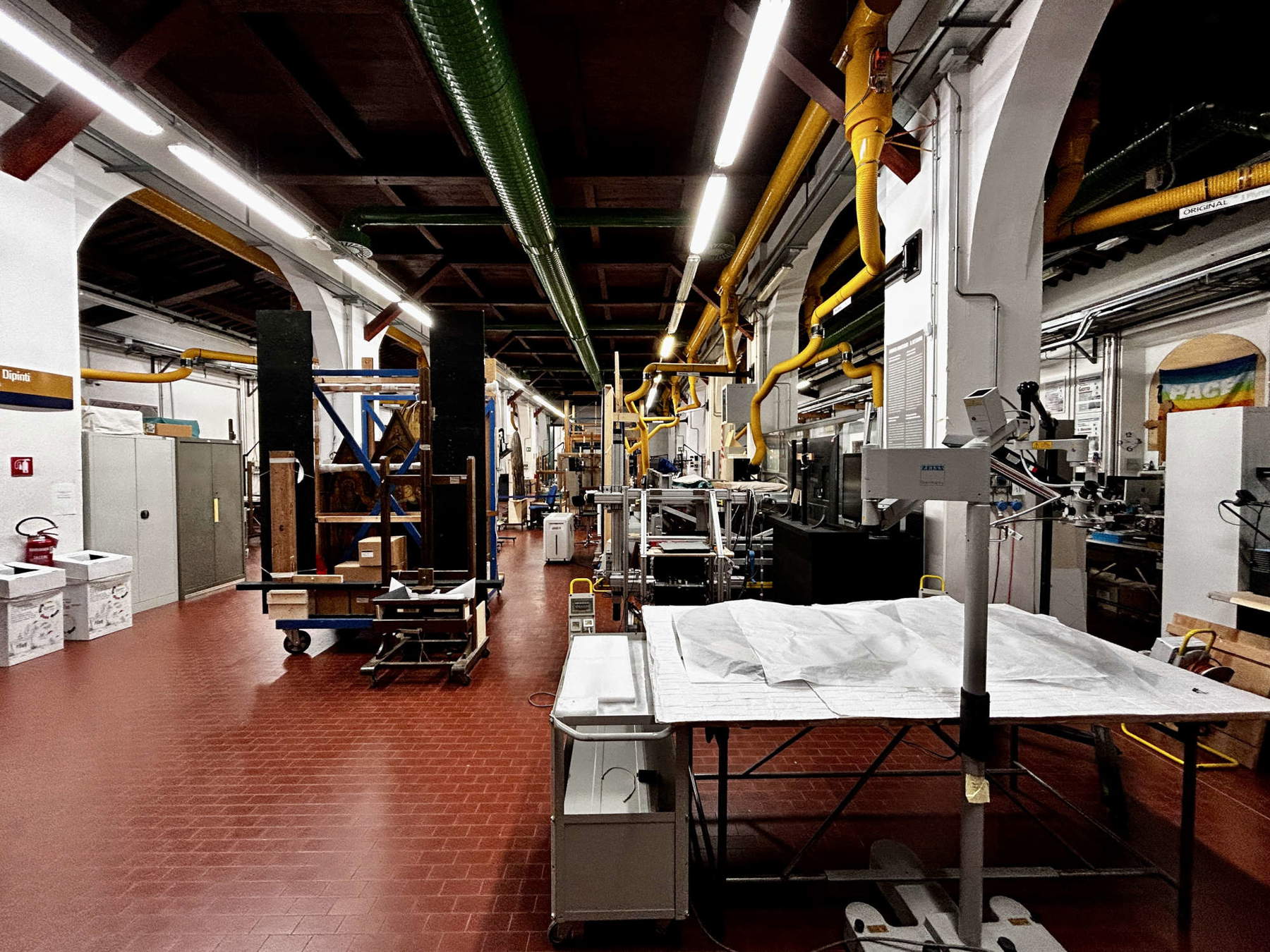


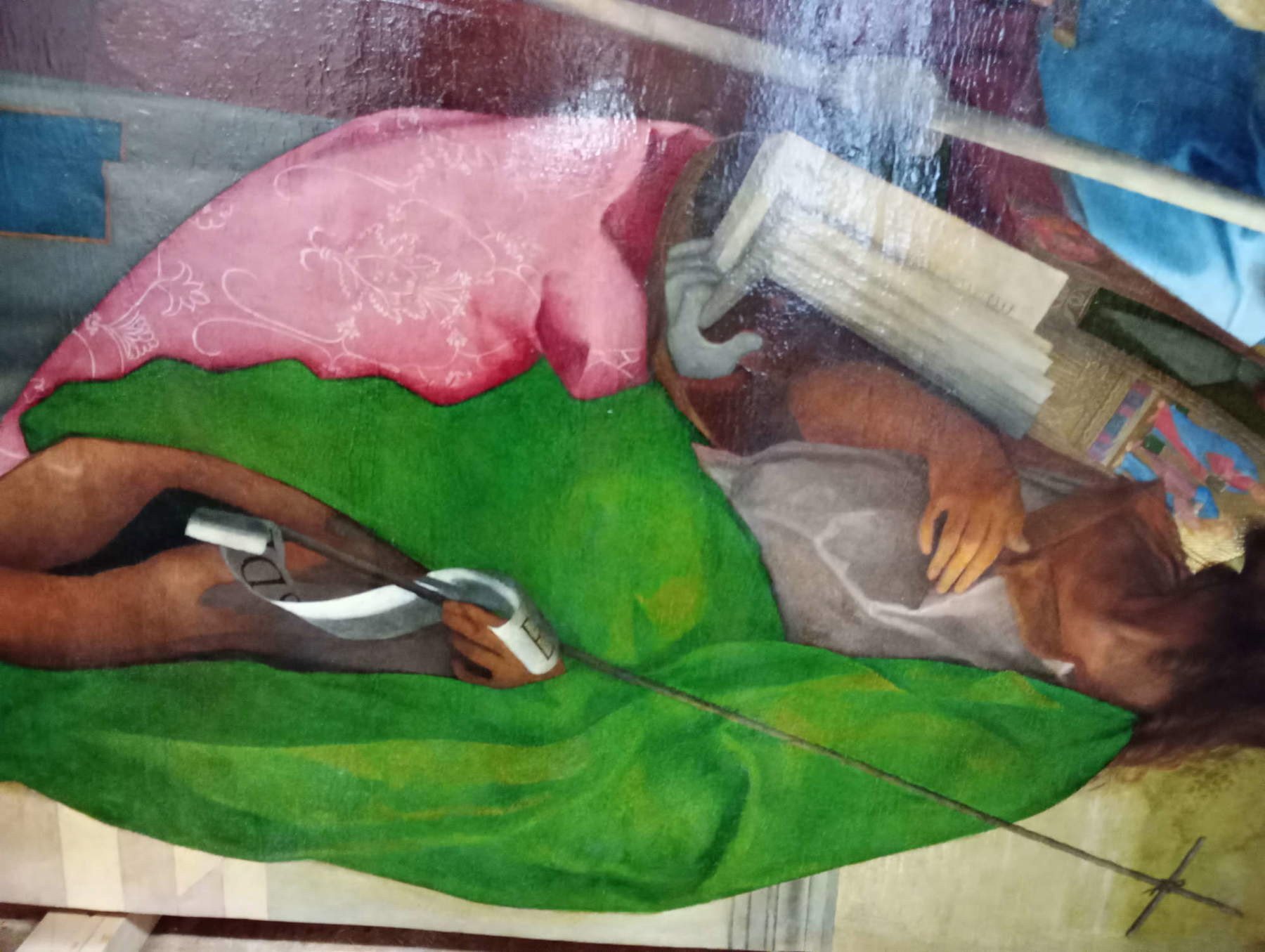
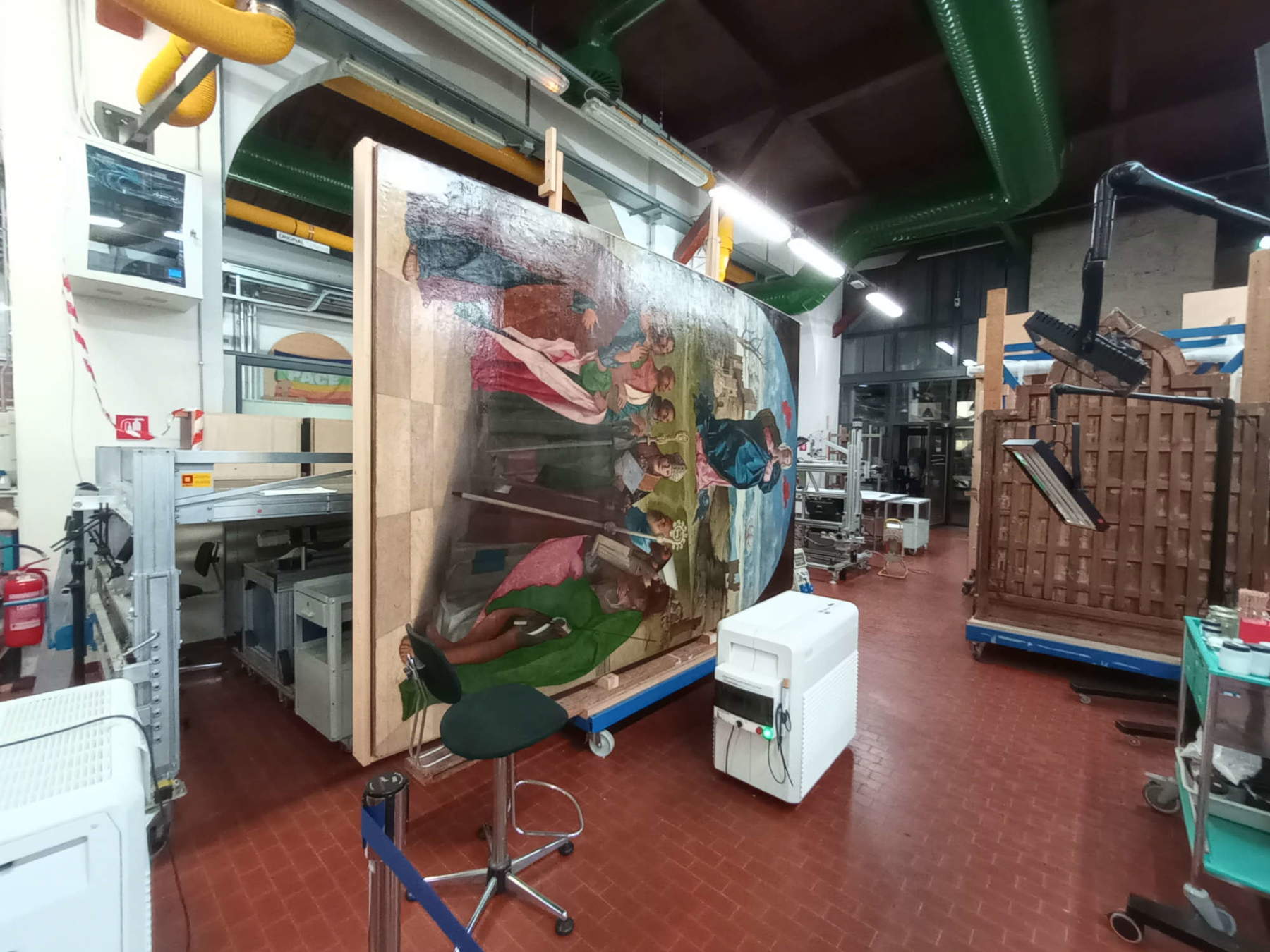 Bellini
BelliniThe first attestation of the name “Opificio delle Pietre Dure” dates back to 1588: it was founded that year, a few months after Ferdinand I de’ Medici ascended to the grand ducal throne of Tuscany, and at the behest of the grand duke himself, the artistic manufactory specialized in the creation of splendid and precious objects in Florentine commesso, stone paintings created by patient artisans who were able to reproduce, by cutting and shaping colored stones, an image drawn and colored on paper. This was an extremely time-consuming and painstaking job that required uncommon technical skills: the best craftsman was believed to be the one who was best able to hide the seam lines between one stone and another. The commesso, in other words, had to appear as a uniform surface. In the Florence of the grand dukes the demand for works in hard stone was very high, so much so that the Opificio continued to work with fertile activity even under the Lorraines. Then, after the Unification of Italy, changes in taste and the lack of the support that the grand duchy had always granted to the Opificio forced the manufactory to look for new ways to sustain itself: first, it tried to carve out an autonomous role for itself in a market that was, however, increasingly asphyxiated. Then, since the retail sale of works was not enough, between the 1880s and 1890s the then superintendent, the painter Edoardo Marchionni, thought of updating the skills of his artisans, putting them at the service of the restoration of works of art, an activity that was beginning to develop and establish itself. As early as 1892, an anonymous journalist from the magazine Arte e storia, describing a maintenance operation on Giambologna’s Rape of the Sabine Women (a pivoting of the unsafe parts), considered the operation to be a “most important essay of the usefulness of employing the personnel of the Opificio delle Pietre Dure in the restoration work of monuments.” Thus began the second life of the Opificio, the one that still continues today, the one that is perhaps even better known.
There was then, in the institute’s history, a definite “turning point,” as Sandra Rossi, director of the institute’s canvas and panel paintings sector, calls it: the Florence flood of 1966. “In the misfortune,” she explains, “the great strategic choice was to have the works under restoration arrive here, during a moment of awareness and strong international mobilization regarding Florence’s heritage. The modern Opificio was born in that dramatic context, on the one hand because the city attracted skills and knowledge that were all concentrated here, and on the other hand because the extent of the damage forced the restorers who were active here to measure themselves against problems of enormous magnitude, forcing them to progress, to move forward. The best modern experience and the best skills came here, and work was then done to pass on the skills gained at that juncture.” The disaster, in essence, imposed on the Opificio the need to research methodologies, to activate the exchange of knowledge, to foster the transmission of knowledge. The institute thus began to specialize in the treatment of extreme cases, of remedies for the most desperate cases. The current configuration of the Opificio also derives from the catastrophic event: the Cabinet of Restorations of the Superintendence of Florence, which was founded in 1932 by Ugo Procacci and which can be considered the first modern restoration laboratory in the history of Italy, after 1966 was transferred from the premises of the Old Post Office at the Uffizi, which had been seriously damaged during the flood, to the large halls of the Fortezza Da Basso, which because of their size were the most suitable for housing a large number of works. The Fortezza is still the Opificio’s main headquarters: in fact, the Gabinetto and the Opificio were merged into a single institution in 1975, which, moreover, was promoted by Law 44 of 1975 to a central institute of the then nascent Ministry of Culture, headed by the Florentine Giovanni Spadolini. Not without debate: on the one hand, the elevation of the Opificio to a central body was believed to be the natural outcome of the concentration of skills and professional resources that had occurred since the flood and at the same time also the basis for a regional specialization of restoration activities (so we read in the reports of the design from which Law 44 derived, although the project is still beyond completion), on the other hand the same measure was seen as the prerequisite for a long dualism with the Central Institute for Restoration, which found itself no longer the sole point of reference (moreover, since 1983, after Urbani’s resignation, Umberto Baldini, who had directed the Opificio since 1975, was appointed to the ICR as director). The Opificio is now divided into several restoration sectors: paintings on canvas and wood, paper and membranous materials, wall paintings and stuccoes, wooden and polychrome sculptures and textile materials are located at the Fortezza da Basso; the bronze and antique weapons, goldsmithing, ceramic, plastic and glass materials, stone materials, mosaic and Florentine commesso sectors are housed in the premises on Via degli Alfani; finally, the tapestries and carpets sector is located in Palazzo Vecchio, in the Torre di Arnolfo. Alongside the restoration sectors, the Opificio has a visitable museum, in Via degli Alfani, and a very active training school founded back in 1975 on the model of that of the Central Institute for Restoration.
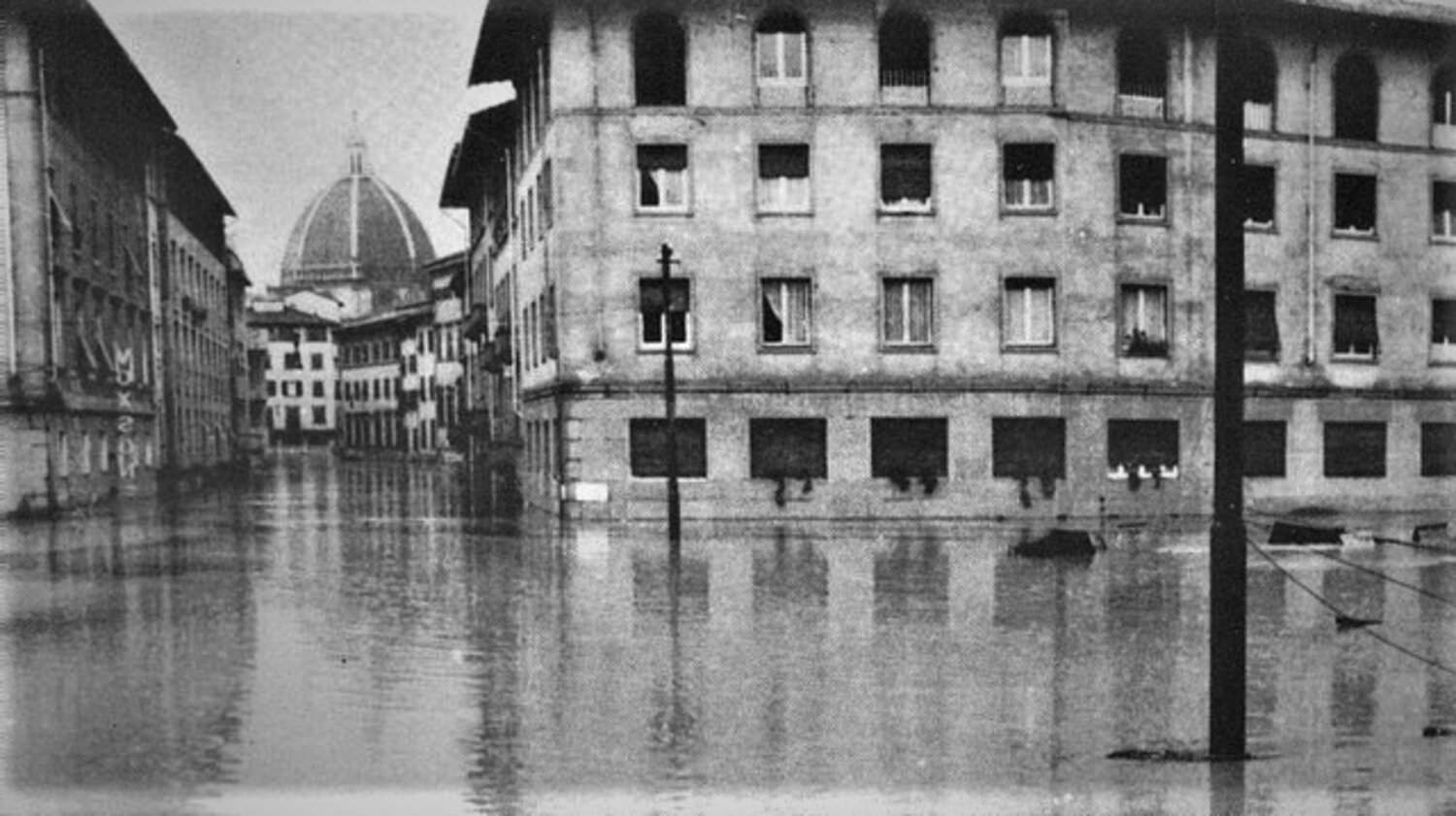

Shortly after the entrance to the Fortezza da Basso premises, a huge fire door opens. Cross the threshold and you are already in the heart of the paintings on canvas and board section. One only has to take a few steps to get the feeling of having stepped inside an art history textbook that has momentarily gone under the surgeon’s knife. One immediately encounters Raphael’s Madonna of the Canopy , here for a check-up after the Pescia exhibition, before returning to the Pitti Palace. A little further on, however, here is Giovanni Bellini’s Madonna in Glory . A restorer is working on a panel by Beato Angelico, the Madonna and Child from the Museo Nazionale di San Marco. In another room is Cosmè Tura’s Saint Anthony , from the Estense Gallery. A careful choice is made about what should pass through the hands of the Opificio’s professionals: in some cases, the superintendent explains to us, it is the institute itself that chooses on which works to intervene, for reasons of interest or research. For example, she tells us, at this historical moment the Opificio is very interested in research on environmentally friendly materials. Or, the choice comes when dealing with works that are particularly interesting from an art-historical point of view: the prime example is Leonardo da Vinci’sAdoration of the Magi from the Uffizi, whose restoration has revealed important discoveries about the painting. The highest number of Raphael’s panels passed through the Opificio’s halls, a circumstance that led scholars to gather detailed information not only on the Urbino’s technique, but also on his stylistic evolution. In other cases, however, restoration is requested by those who own the works, but the choices are always formulated on the basis of the two criteria just mentioned: research interest and importance of the work.
However, there are also definitely less usual objects. As we wander inside the workshop, for example, a restorer is working on two 16th-century parade wheels. We are still in the early stages of the restoration work, which was preceded by the documentation that is always carried out prior to the operational phase on the object: photographic campaign, ultraviolet light photos, radiography and other investigations. These casters are rather anomalous objects: they have all the constituent elements of panel paintings, but they are weapons. Therefore, the construction techniques are also different from those found in the art treatises of the time, which restorers can refer to while working on the works. An interesting intervention, then, for several reasons: because they are unusual artifacts, because it is necessary to understand which workshop they come from, and also because the restorers who are working on the casters have noticed that, although obscured by later interventions, there is a layer of gold leaf whose extent still needs to be assessed; there are gaps to be repaired: restoring the material also means recovering the image, getting a more complete legibility of the work.
And then, there is also the work that the public does not see, but which is perhaps even more important, because it serves to preserve the support. This is what Luciano Ricciardi, a young restoration officer grappling with Cosmè Tura’s Sant’Antonio , shows us. Around the 1930s, someone tried to flatten the panel by force, pressing it against a plane (even then it was rather boarded up), and then replaced the original crosspieces of the support with new, stiffer ones: for the knowledge of the time it was natural to proceed in this way, because it was thought that a stiffer support would deform less. Today, on the other hand, we know that it is good practice to make the support more elastic, so that it does not give way in the weaker parts (as was punctually the case in Cosmè Tura’s panel) and thus does not end up ruining the surface. “We are going to create a new crosspiece system around the only survivor of the original crosspieces,” Ricciardi explains. “The others were made of a very hard wood and are no longer usable. So we will develop a more elastic system that allows for deformations, yes, but within certain limits.”

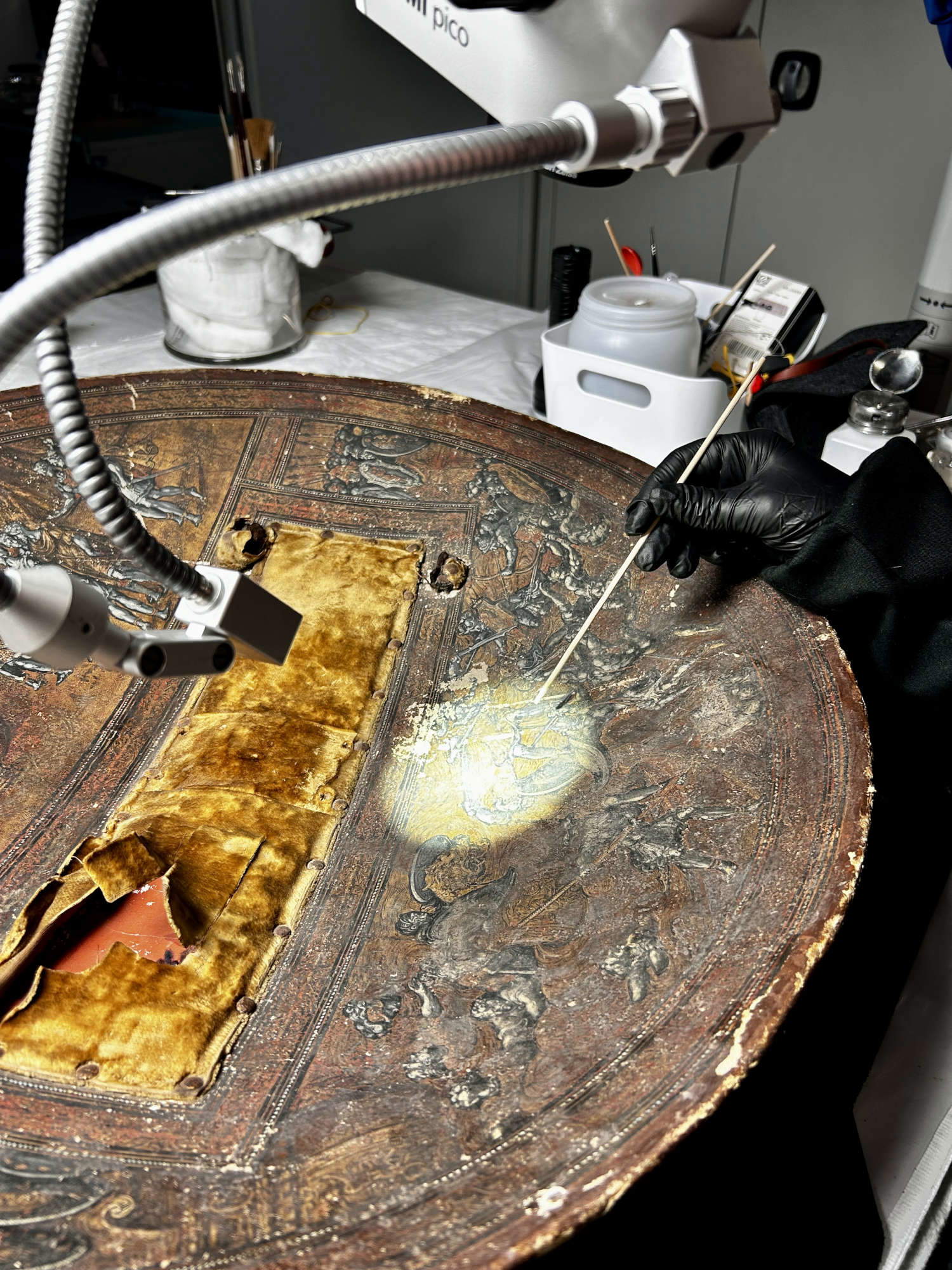
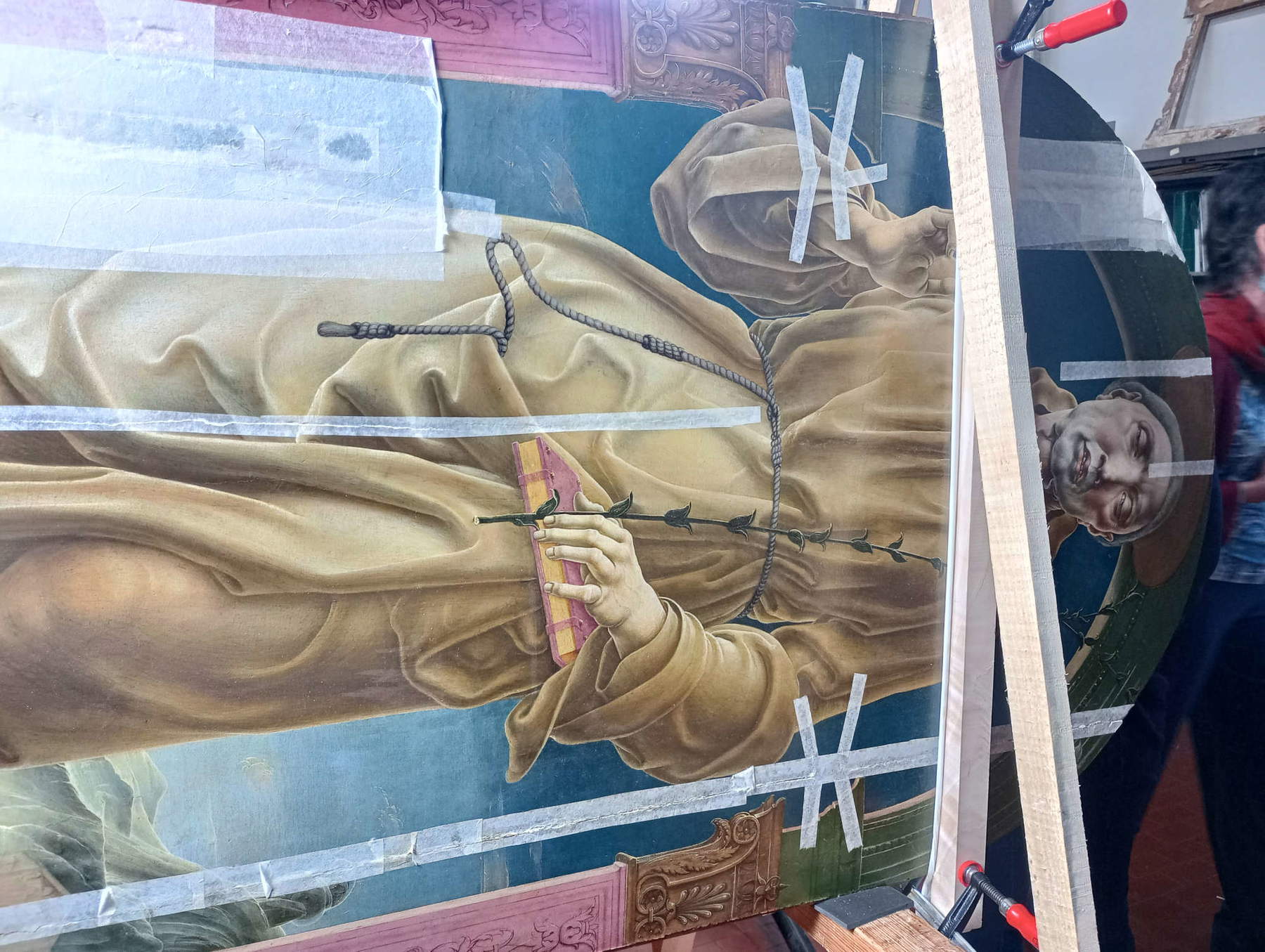
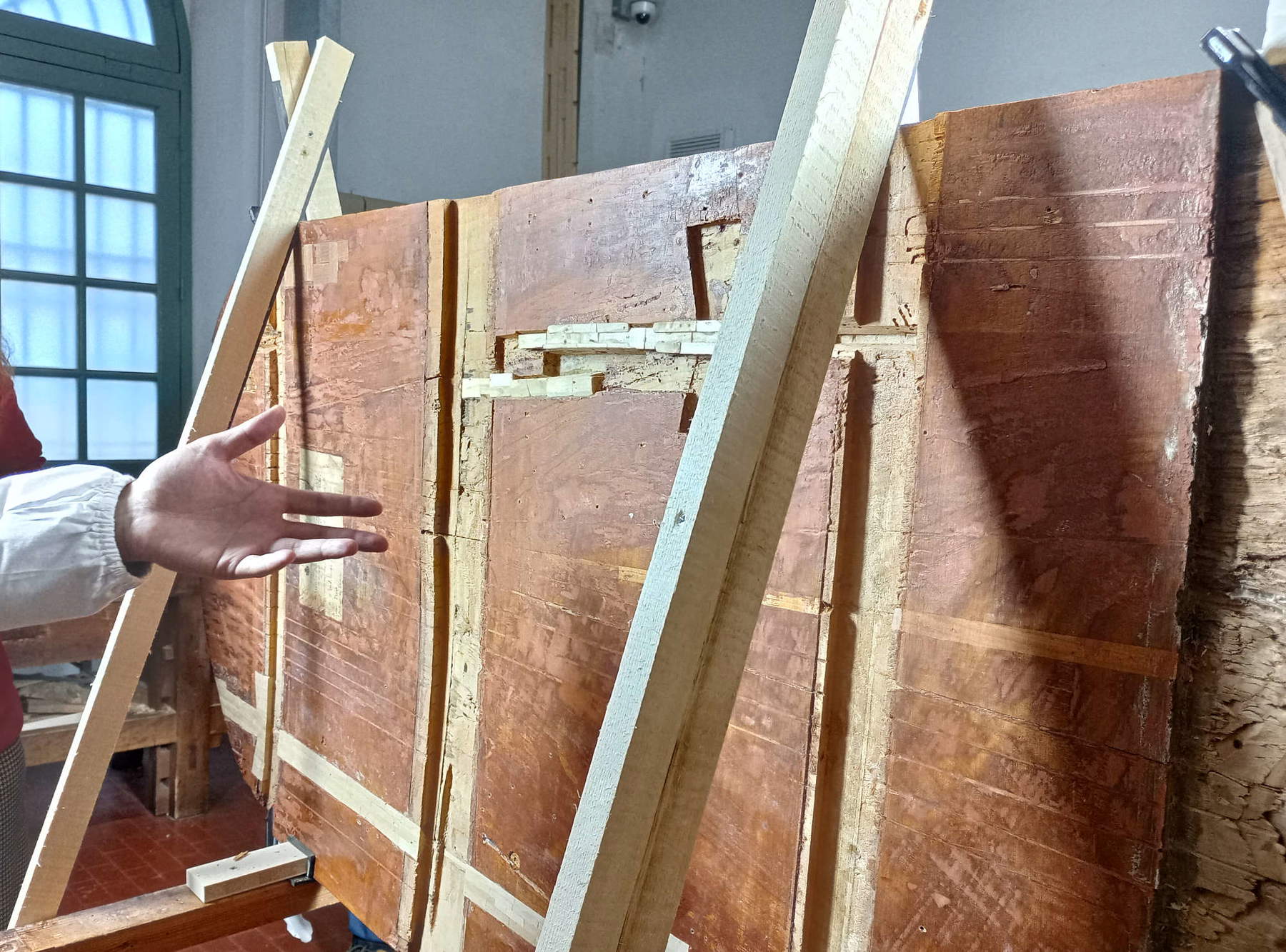
Lying on top of a large table is an early 15th-century wooden statue, a Madonna and Child. Two restorers are at work on the work-Rita Chiara De Felice and Claudia Napoli are both officials in the Polychrome Wooden Sculpture sector, although they belong to two different generations. Superintendent Daffra explains that it is typical practice at the institute to have more experienced restorers work together, on the same works, along with their younger colleagues: it serves to facilitate exchange, to encourage the transmission of knowledge. A restorer always has something to learn, even if long training is required to get his hands on a work. Italian regulations require that a recognized restorer must come out of a certified school (the Opificio, the Central Institute for Restoration, the Venaria Reale Restoration Center, some academies), or have experience, certified by a superintendency, of at least eight years. Of course, then it will be the conservation body that will target a particular professional: a restorer may have all the credentials to be qualified, but the body deciding on a restoration may feel that he or she does not have sufficient experience to work on a particular work, or that his or her professionalism is better suited to one object than another. Translated: it is not as if a restorer fresh out of a school can immediately go out and work independently on a Leonardo da Vinci panel. As with any trade, his or her career will start in stages, taking off from more affordable projects.
Claudia Napoli is one of the Opificio’s youngest restorers, but she already has considerable experience. She joined the institute with the 2018 ministerial competition, although she was already doing this job before that, and she has no reverential fears about the medieval statue she is taking care of: she is engaged in repairing the gaps in the polychrome surface. The work, she explains, was full of repainting: so first a major cleaning operation was needed to recover the remaining original pictorial film. Then, where it was missing, she and her colleague proceeded with a plastering that they are now covering with additions. “Obviously,” she tells us, “with reversible and recognizable techniques.” What she is applying, she is careful to specify, are retouches, and not repainting: “Repainting,” she explains, “is applied to the original film and tends to wear it out. Retouching, on the other hand, goes on the grout. And the viewer tends not to notice the difference: the eye goes to synthesize the lines that we juxtapose and will have the perception of a homogeneous whole. So he will see vivid colors, a soft gradient. Then, at close range, a scholar can see where we have intervened. The intervention, however, is absolutely necessary to recover the legibility of the work.” In several places, the surface of the sculpture had been ruined by woodworms, adds Rita Chiara De Felice. “First we had to do a disinfestation in anoxia, through nitrogen. Then we closed all the little holes caused by the woodworms, after treating them with permethrin against future attacks. Closing the holes is not only to improve the aesthetics of the sculpture, but is also necessary for conservation reasons: woodworms lay eggs there.”
It is a long, complex, delicate work, and above all, with a time frame that is difficult to predict. A restoration, to give an example, is a bit like a tennis match: you know when it starts, but you don’t know when it ends, although you can have a rather plausible, albeit vague, idea of how long it might last. The timing depends substantially on the state of preservation of the work: a sculpture may arrive for which the problem is solely the removal of paint, now altered, from a previous restoration, and in that case the process will be quick. In cases like the sculpture in front of us, the operations are longer, since the work had as many as five layers of repainting. “The time is longer,” Claudia Napoli explains, “because we have to identify the correct method that will allow us to remove the repainting without going to compromise the original. Of course, since it is a sculpture, we also have to take into account the fact that we have the modeling, so there are some points that are easy to access and others that are difficult to access. We generally try to budget realistic times, and sometimes the unexpected happens.” What kind of unforeseen can happen? “For example,” De Felice replies, “a repainting that is very difficult to remove, which presupposes a study in itself, a testing phase in order to find the appropriate cleaning method. Wooden sculpture is one of the most complex areas of restoration: wooden statues, being devotional objects, have had so many layers over the centuries, because in ancient times restoration was not conceived as we conceive it today. In ancient times, at most, the statue was given a refresh, a brightening, a repainting. So when a work comes to us, it is impossible to calculate exactly what we will find underneath. When you work with a painting, no matter how much the varnish is altered you can still get an idea, however slight, of what is underneath. With a wooden sculpture you cannot know: by removing repainting we might find an intact surface, but we might also find substantial gaps, perhaps in the order of 70-80%. And so the decision is made: clearly, if the surface is compromised to the point that the sculpture must be restored to wood because there is no more color, then the decision is made to keep the repainting, choosing at least the layer closest to the original.” In a paper he wrote in 1956, architect Alfredo Barbacci, best known for restoring Pienza Cathedral, listed what he thought should be the restorer’s gifts: “morality, intelligence, culture, taste and also patience.” Coming out of this workshop, one easily realizes that the last of these qualities is not really an accessory.
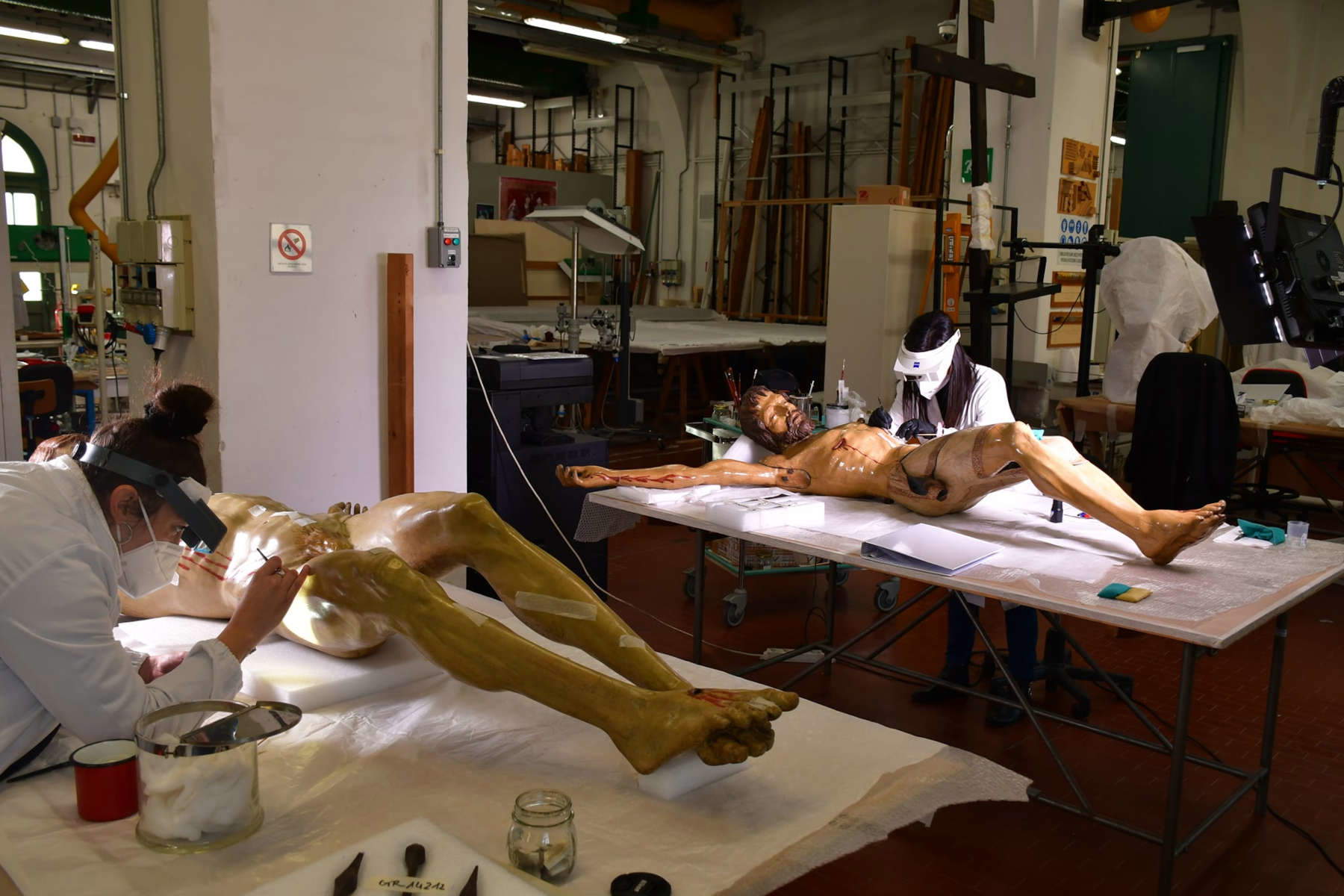
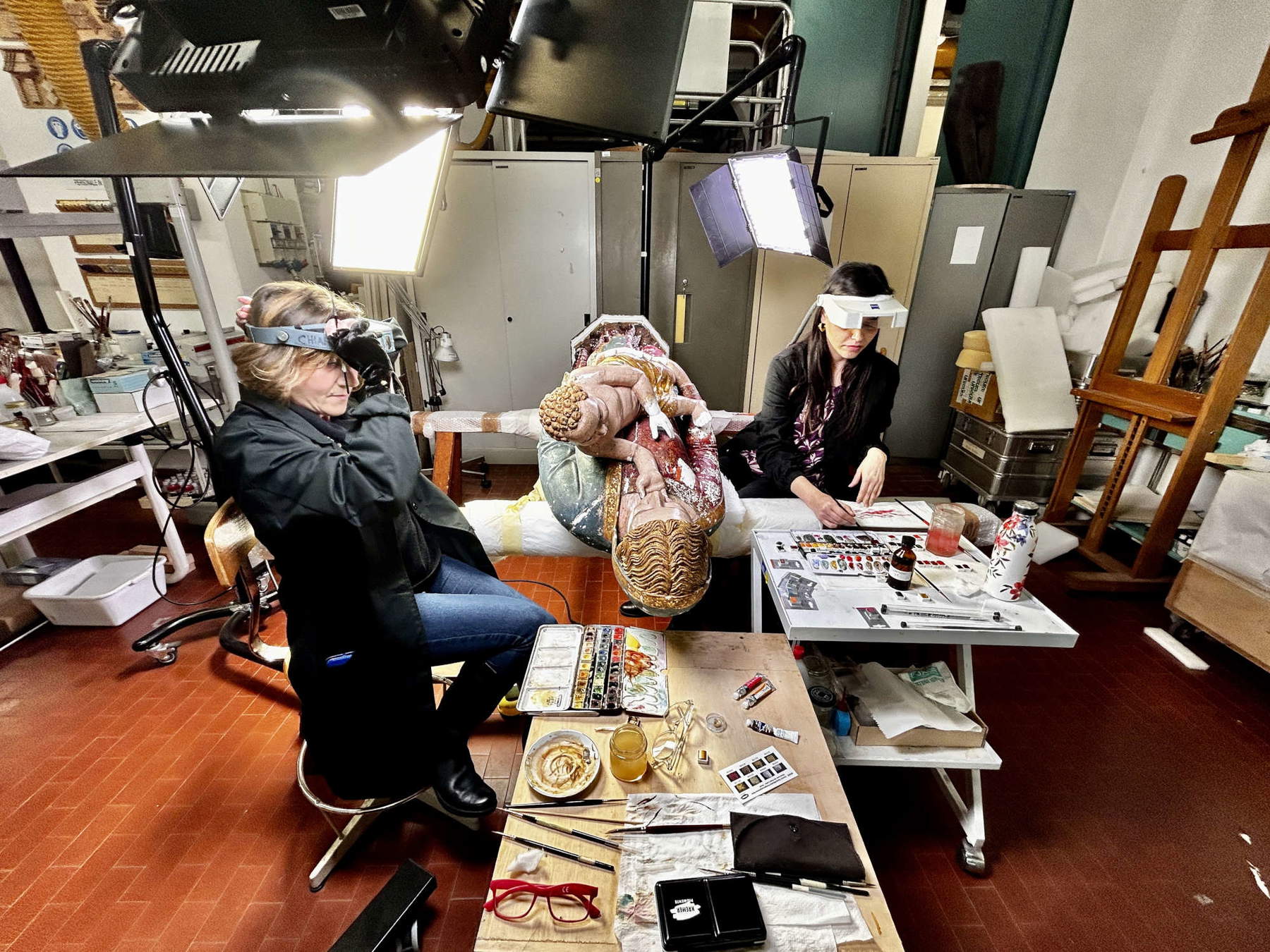
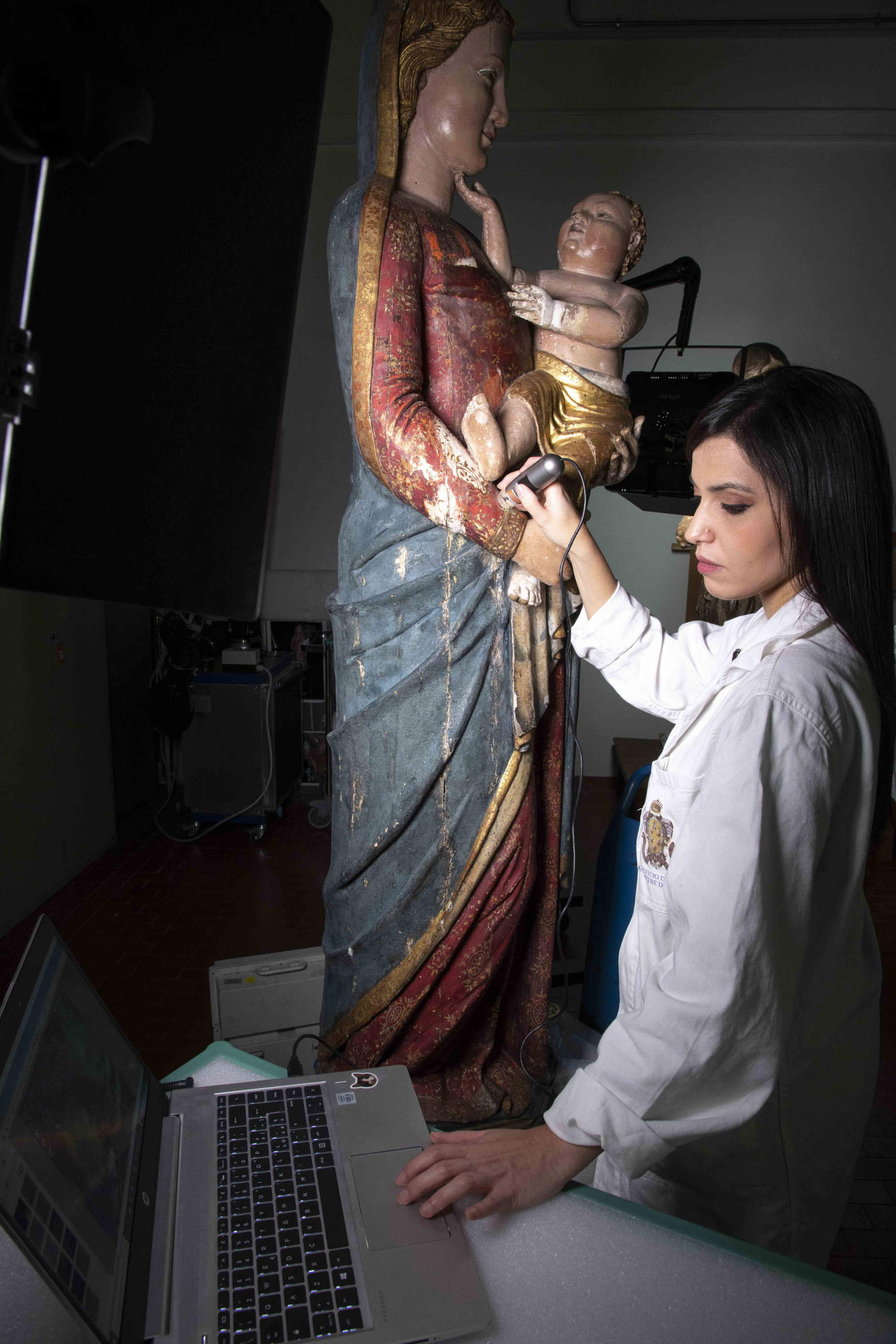
One floor of stairs and the Opificio’s landscape changes. The rooms on the upper floors of the Fortezza Da Basso are smaller in size, ceilings at lower heights, and rooms more intimate. One wing houses the scientific laboratory: chemists, biologists, climatology and diagnostics experts work here. In the other, on the other hand, are the textile and paper restoration sectors: objects, therefore, that do not require large spaces. If one were looking for something particularly flashy, one would struggle to find material to satisfy one’s curiosity. There are, however, some extraordinarily striking pieces, such as those shown to us in the textile workshop. A few years ago, the National Archaeological Museum in Naples entrusted the Opificio with the restoration of its Textile Collection, and among the artifacts that arrived in Florence are some fragments of gold fabric that have amazed everyone, even the restorers who work here and who have certainly seen it all in their careers. We don’t really know what they are: Riccardo Gennaioli, director of Textile Materials, explains that they are supposed to be ribbons that were inserted into garments, perhaps borders, or hair nettings, the so-called reticulum that were worn by Roman matrons. We have little certainty: we know they come from Pompeii and date from the first century A.D., we know that the gold used to weave these ribbons reaches 99 percent purity (a rare circumstance, moreover), and that’s it. We have no idea how they were spun: “they are objects still somewhat shrouded in mystery,” Gennaioli points out. “We are surprised by the technique of making them, which is very sophisticated: even with today’s technology, one would struggle to achieve the same result. Even in today’s large production centers, such as Arezzo or Valenza, no goldsmith company is able to replicate this technique. These are not yarns made from threads pulled through a die: they are, in practice, metal helices wrapped around a yarn core, a few microns thick, so we are talking about millimeter percentages. A hair and a half, just to get an idea. At present we know of no written sources that indicate how the weaving of these materials was done, and we have no idea of the existence of machinery capable of such fine work. It is highly likely that this work was done by hand.”
These are extremely fragile objects: simply touching them is enough for them to lose material. Therefore, the Opificio had to not only work on these fabrics (a special dirt cleaning was done with micro-suction), but also invent special containers that would keep them in the forms in which they came to us (curled, twisted, clumped, and so on), and that would be able to absorb shocks that could devastate them. Even the slightest blow could turn them to dust. Most importantly, the containers will allow the MANN to display them: two showcases are being set up to make them visible to the public, which has never had the opportunity to view them precisely because of the difficulty of moving them and placing them inside a display case. Turning your back on the MANN textiles, you can leap forward almost two thousand years, because on the other side of the workshop an intervention is underway on two costumes by Gino Carlo Sensani, one of the greatest costume designers in history: “the only ones we know of his production from the 1920s,” points out restorer Licia Triolo. They are kept at the Fashion and Costume Museum in the Pitti Palace. “Stage costume restoration is developing more and more,” Triolo explains. “And we here try to combine these the methodological aspect and the intervention aspect.”
Every piece, every artifact, every material that passes through these laboratories actually presupposes painstaking work, which often includes a substantial amount of research. This is one of the aspects for which the Opificio stands out. Many of the restorations are documented in minute detail, and accompanied by scientific publications produced by the institute itself, which publishes the journal OPD Restauro, anthologies, and book series. Restorer Letizia Montalbano, technical director of the Paper and Membranous Materials sector, has a resume dense with a long sequence of scientific publications. She is among the few who can claim to have worked on works by Leonardo da Vinci. Although trivial, it comes as a given to ask her what it feels like to touch the product of the hand of one of the greatest human beings to appear in history. “It always frightens. One always has to take a step back before doing anything, and study a lot,” she tells us. “Then, with Leonardo in particular, you never stop discovering. He was a great experimenter, in drawing sometimes even more than in paintings. New techniques he introduced in the late 15th century, techniques that didn’t exist. I have also recently worked on Raphael, but Raphael is a more linear artist. With Leonardo you cannot say the same thing.” Among the works that the sector directed by Montalbano has just finished working on is a poster by Alfons Mucha: it is surprising to find such a work here, since one would be hard pressed to think of an Opificio delle Pietre Dure working on a piece that was created to have a short life span, given that we are talking about an advertising poster pulled in many copies. This one, however, has an illustrious provenance since it comes from the Salce Collection in Treviso. More importantly, it represented a major challenge for the restorers who restored it, since it was in apparently desperate condition. Almost destroyed, at least to see the “before” photographs. It was in fragments and had been lined with strips of tape. And then, given its nature, it had been printed with poor quality materials: industrial papers and colors designed certainly not to have a long shelf life. “The biggest problem,” restorer Barbara Cattaneo explains, “was to find a methodology to remove the adhesive tapes and then to heal the tears, the small gaps and the overmissions of the poster: there were in fact parts that had been folded over and, in order to give a sort of flatness to the poster, had been superimposed. We then experimented on localized forming systems of all the tears that were gradually applied and then removed as the various fragments were relocated. Now the intervention is over, we have finished the color integration, the work has been lined and finally mounted on a durable support for conservation. Given the initial conditions, we couldn’t believe it either!”
The restoration of Mucha’s poster is also interesting for one particular aspect: the intervention is the result of a graduate thesis. Those who study at the Opificio delle Pietre Dure’s training school must end their studies with practice: the student, guided by his professors, chooses an object to restore (the selection starts from the student’s interests, and the professors try to find the object that comes closest to the student’s characteristics), and begins to work on it. Sometimes noteworthy works come out of it, like the one Letizia Montalbano is showing us now: an album of drawings by Baldassarre Franceschini, known as the Volterrano, one of the major artists of mid-17th-century Tuscany. The album is the property of the Longhi Foundation in Florence and is the last remaining from the collection of an old collector, Giuseppe Santini, a military engineer who lived in the seventeenth century (he was a student of Ferdinando Tacca), who had nineteen: all dismembered and lost. This collector had collected a series of drawings devoted to draperies, sacrificing, however, in order to glue them together, the verso of the sheets, since they were all drawn on both sides: the intervention on the album allowed the recovery of dozens of unpublished, drawings by Volterrano that, being concealed as they were collated, no one except Santini had ever seen. Now the Opificio has also studied a mounting system that allows the sheets to be observed on all sides. A year to arrive at the final result.
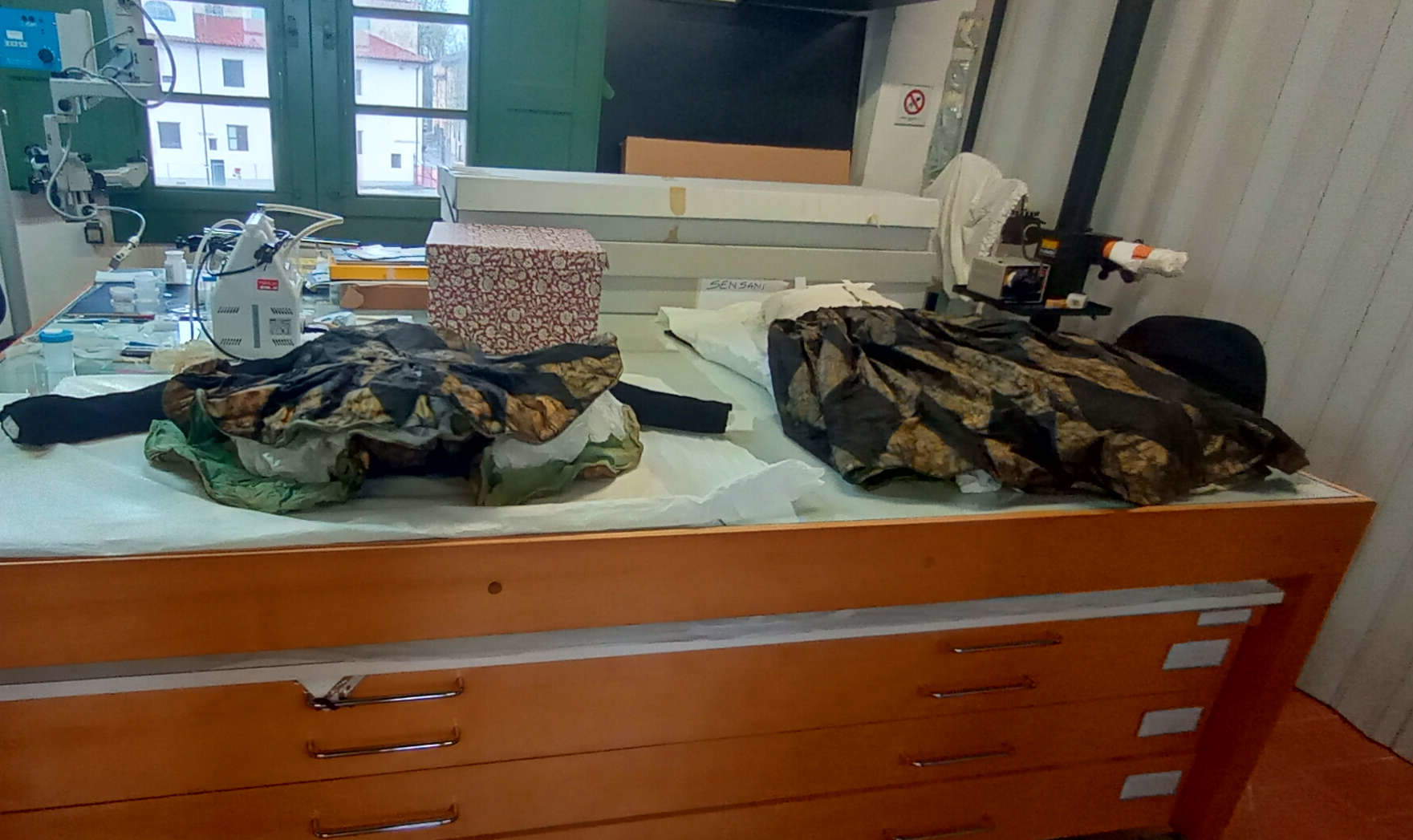
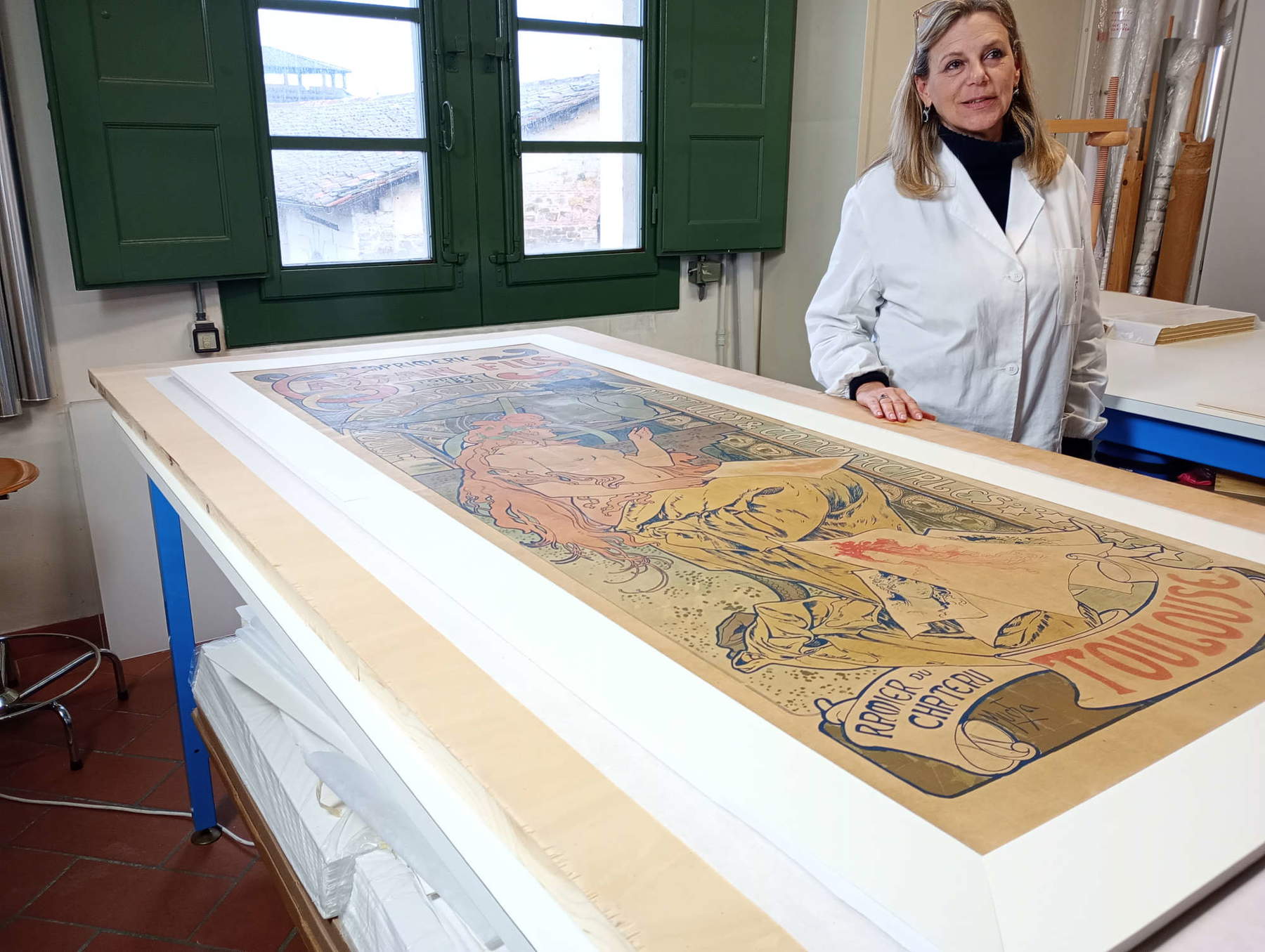

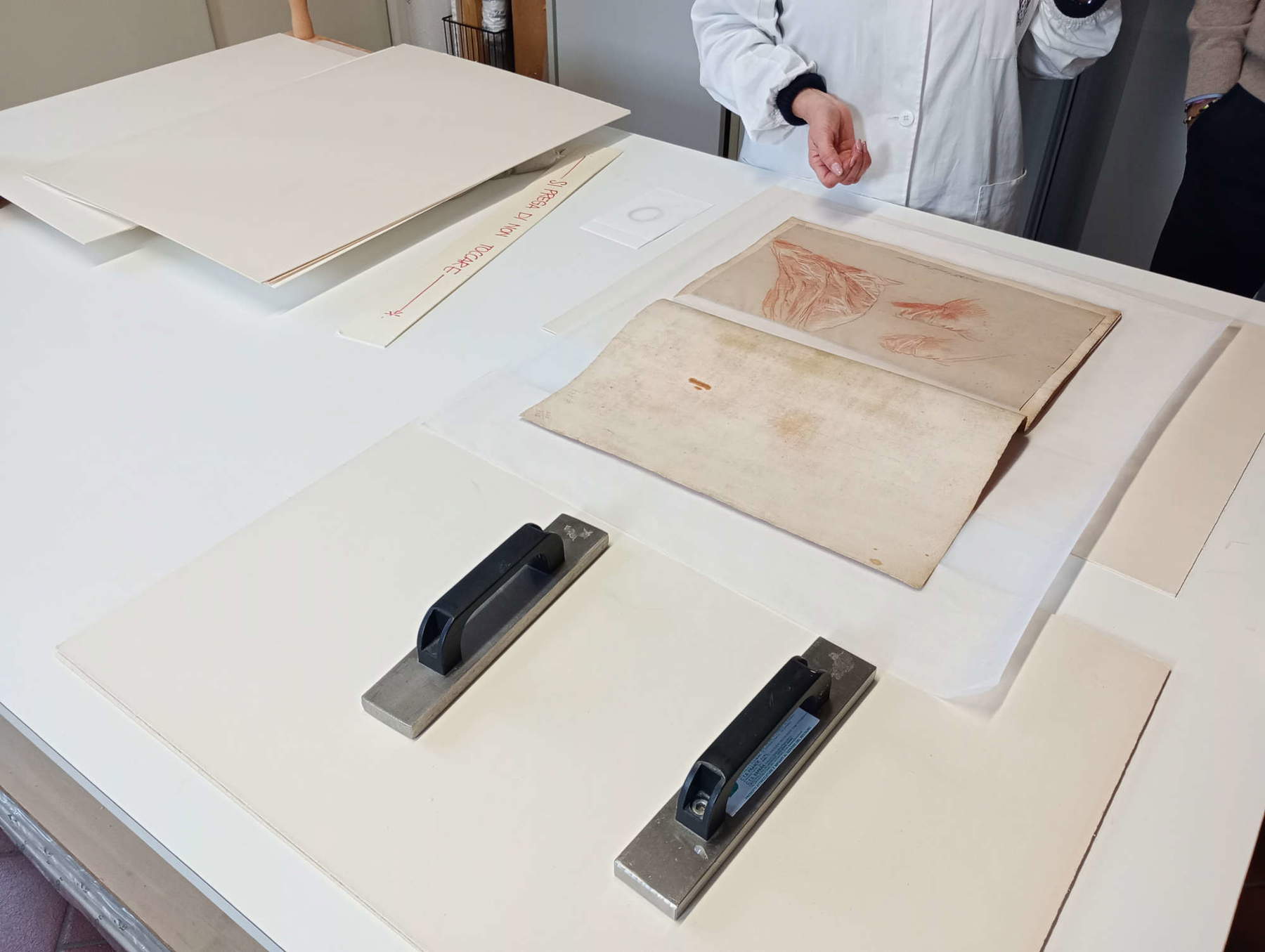
In springtime Florence, the queue of tourists eager to enter the Accademia Gallery to see Michelangelo’s David begins to reach substantial proportions. It’s a rainy day in late March, just past two in the afternoon, but the line already reaches Piazza delle Belle Arti. A few steps away, on Via degli Alfani, the scenario in front of the Museo dell’Opificio delle Pietre Dure, on the other hand, is opposite. No one in line, despite the fact that the museum is in the middle of opening hours: it is almost completely empty, the rooms shrouded in silence. However, there is a way to miss the bustle of the street without leaving the building. From the entrance of the museum, instead of entering the halls, one goes through a door that overlooks the inner courtyard of the building, and enters the first room that overlooks the courtyard: it is the Opificio’s bronze restoration workshop. We have to raise our voices a little to cover the noise of the suction arms, then fortunately someone comes to our rescue, turns off the machinery, and we can go back to talking in a normal tone. Before us, a rare sight: one of the greatest masterpieces of Renaissance sculpture disassembled and delivered to the hands of Opificio workers. It is the bronze facing of Siena’s baptismal font, reproduced in every book on art history of the 15th century. On some of the tiles, the work is already finished. When we enter, restorers are at work on the tile with the Preaching of the Baptist by Giovanni di Turino and on one of the virtues that adorn the corners of the font, Donatello’s Faith , entrusted to the care of Stefania Agnoletti, Annalena Brini and Maria Baruffetti. “All the pieces,” Annalena Brini explains, “have different workmanship. Very interesting for us was Giovanni di Turino, who made the most overhanging figures by casting them apart and fitting them with a hook in the back and an iron wedge to stop. The disassembly allowed us to appreciate the overall state of preservation and in particular that of the iron wedges, which were ruined, much degraded, and therefore no longer suitable for stopping the figures. Ghiberti, on the contrary, made his work by excavating from behind even the most projecting figures, thus ensuring a better state of preservation to his tile.” For the restoration, a general protocol was applied, which consists of an initial dusting, the elimination with steam treatments of the most consistent waxes, the application of emulsions, washing, laser cleaning, repetition of the emulsions, and ending with a series of operations that differ greatly depending on the state of preservation of each individual piece and that involve finishing. The protocol, in short, is declined differently according to the state of preservation of the individual piece. One can easily appreciate the results, if one compares the tile with the photograph certifying its previous state: the gilding of the scene of Giovanni di Turino, previously blackened and blurred, has been completely recovered, one can see with the naked eye details that before the dirt hid, one has a completely different overall impression. “Now we are in the final stages,” Brini adds, “so we are dealing with the application of the protectives. We have done specific treatments, also experimental, for chlorides: they are a very dangerous type of corrosion, favored by the microclimatic conditions of the Baptistery, which are certainly not the most suitable for the conservation of the bronzes.” There are very high humidity rates in the Baptistery of Siena, and the Opificio has asked the Opera della Metropolitana di Siena to take suitable measures to ensure the conservation of the bronzes as much as possible, although these are not easy operations. Nor is it possible to intervene with cases to protect the panels, because, Brini notes, “the font is almost an object of applied art, in the sense that the Baptistery is used and the Sienese are very attached to it.” In short, it takes courage to forbid, to a community extremely attached to an object, the use of that same object. “So we are organizing to do checks, both by eye and with special tools. The whole system of reassembly has been designed in such a way that some portions can be disassembled to go and observe the retrials, and so that we can become aware of any new oxidation phenomena taking place. So, for the time being, we have established monitoring, close observation control of the surfaces. Also because unfortunately some situations evolve very quickly.”
In another room, in the stone sector, another intervention is being completed, on another textbook masterpiece, the monument to Margaret of Brabant, a work by Giovanni Pisano kept at the Museum of St. Augustine in Genoa, which came to us in fragments. “We did X-rays, ultrasound investigations and several other analyses on the work,” Paola Franca Lorenzi, the restorer in charge of the work, tells us. “We understood that there were some metal elements in the sculpture, but we did not know what their shape was, nor what size they were, and of course we could not even know the state of preservation. We understood from the X-ray that the metal elements are fine, so we focused mainly on cleaning them.” We catch Lorenzi moving, in front of the Margherita, a resin model of the sculptural group, produced with a 3D printer from a detailed scan of the work: it is used, he explains, to make simulations on handling, placement. Work on the monument is almost at an end: restorers are currently studying the base and waiting to give the last pass of cleaning to the marble surfaces. Then the ball will pass to Genoa: the Museo di Sant’Agostino is being refurbished, and until the rooms are ready the work of Giovanni Pisano will remain in Florence.
One cannot leave the workshops in Via degli Alfani without casting an eye on the restorers working in the Florentine commesso sector: we can consider them the last continuers of the activity for which the Opificio was founded more than four hundred years ago. There are two of them, young men, sitting at a bench. On the wall hangs a display case with mosaic tiles sorted by color (mosaics are also restored in this room), in front of them are boxes with materials neatly divided: agate from Sabina, chalcedony from Volterra, jasper from Alsace. Some of these “slices,” as they call them (because they are nothing more than cut stones, long or wide), have been here since time immemorial. There are materials that are now unavailable, because the strands from which they were extracted have been exhausted. Restorers are patiently shaping the materials that will be needed to put an 18th-century clerk in place. And the methods are those of the period.
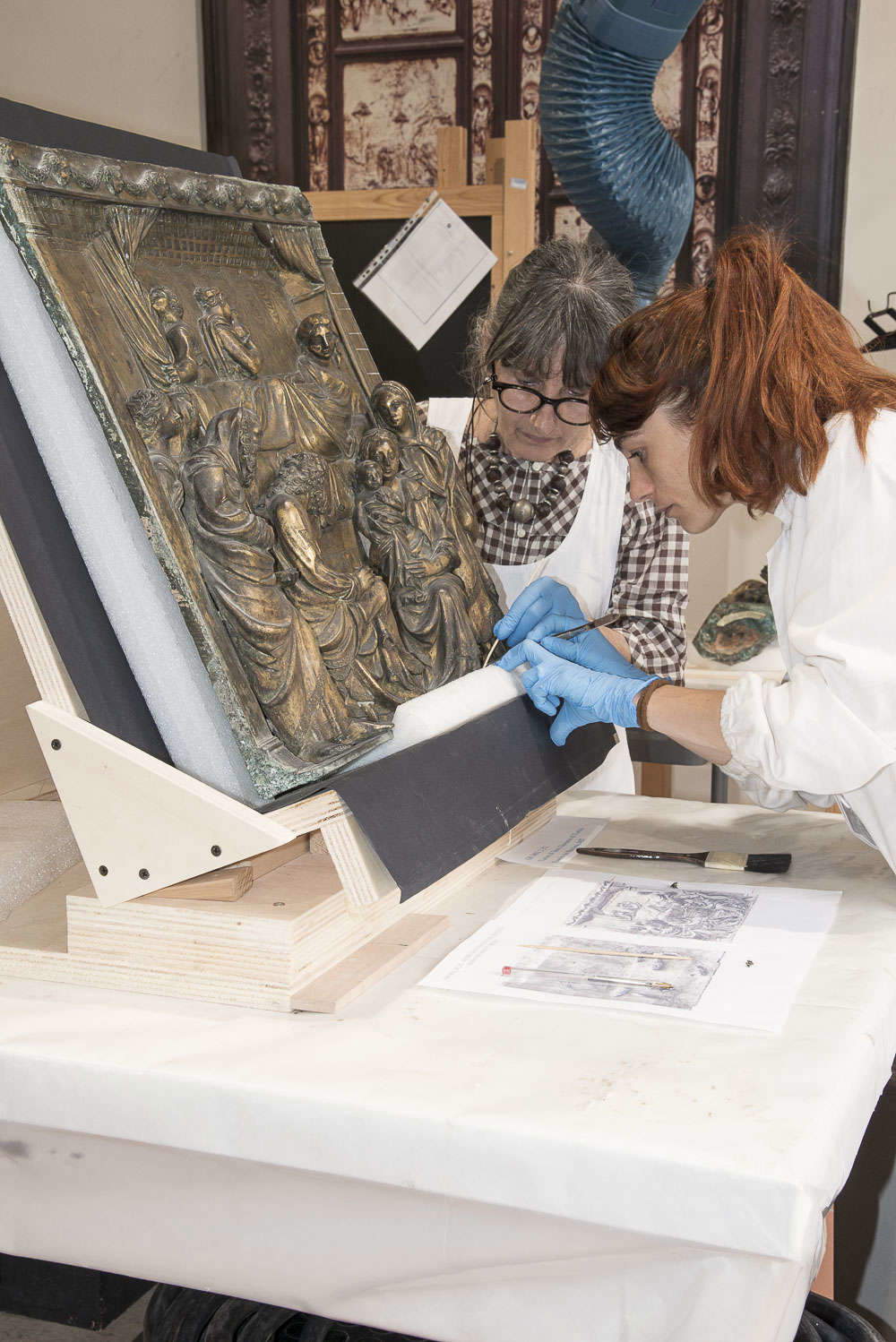
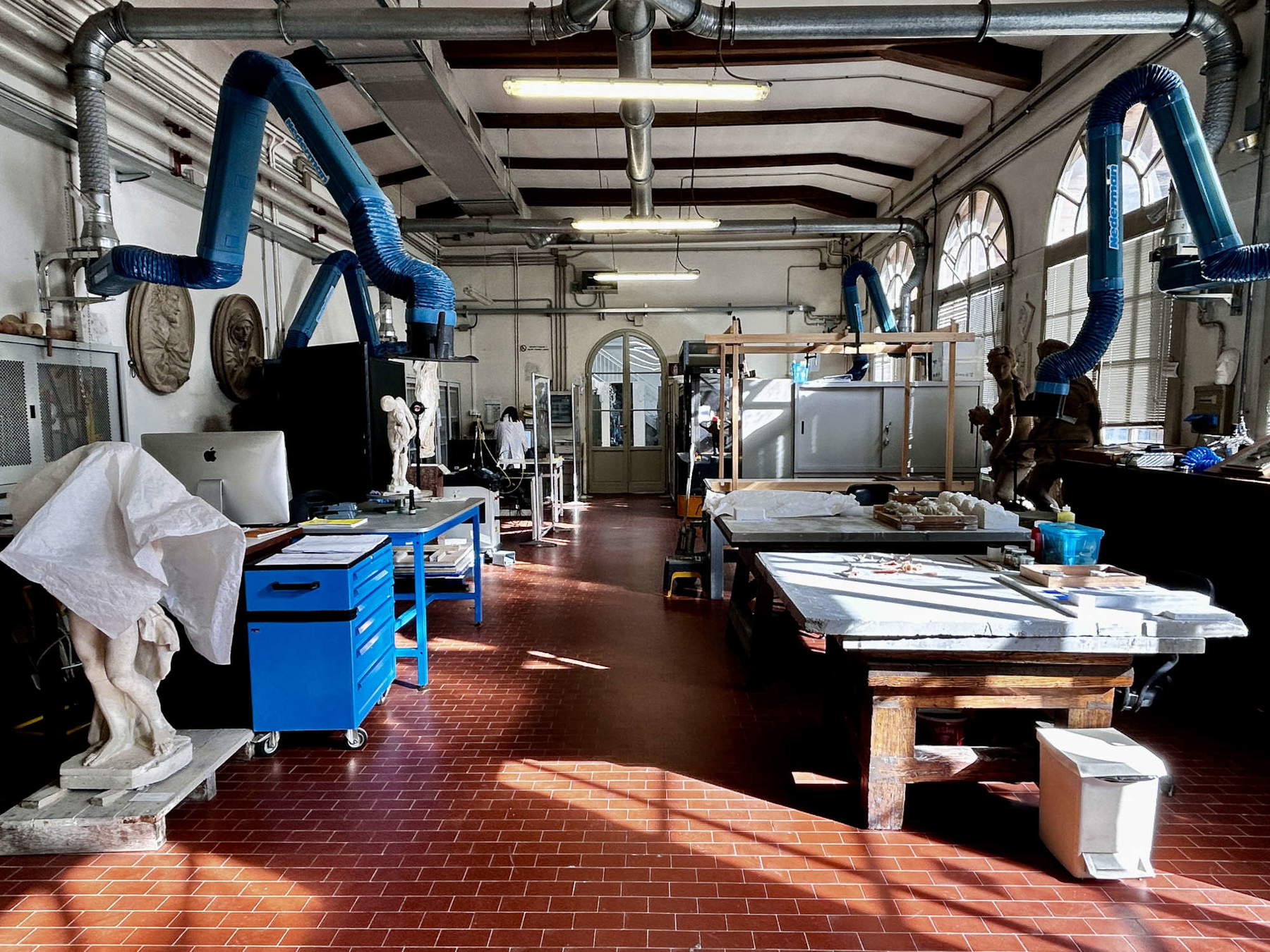 The laboratory of
The laboratory of The Marguerite of Brabant
The Marguerite of Brabant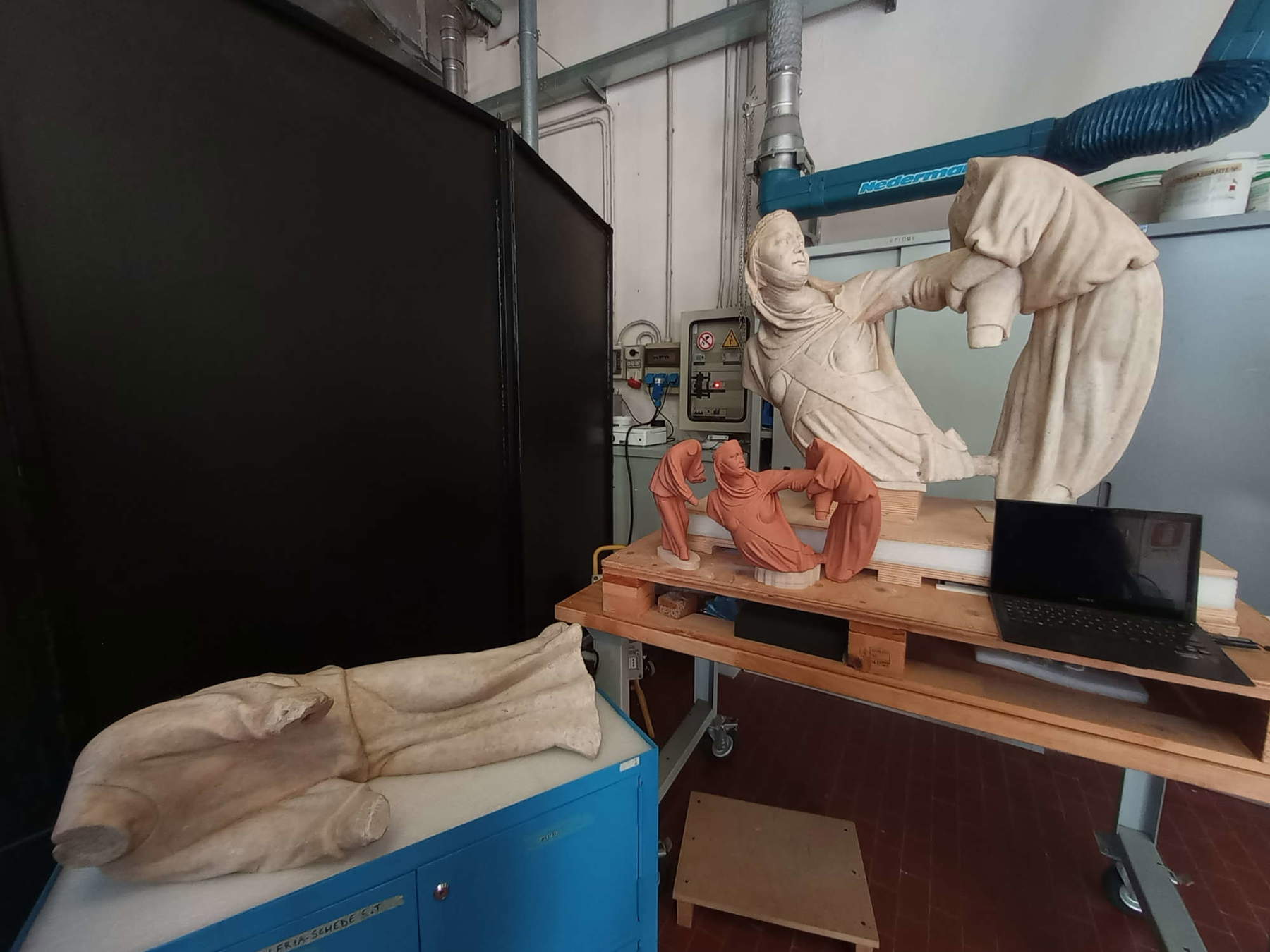 The Daisy of Brabant
The Daisy of Brabant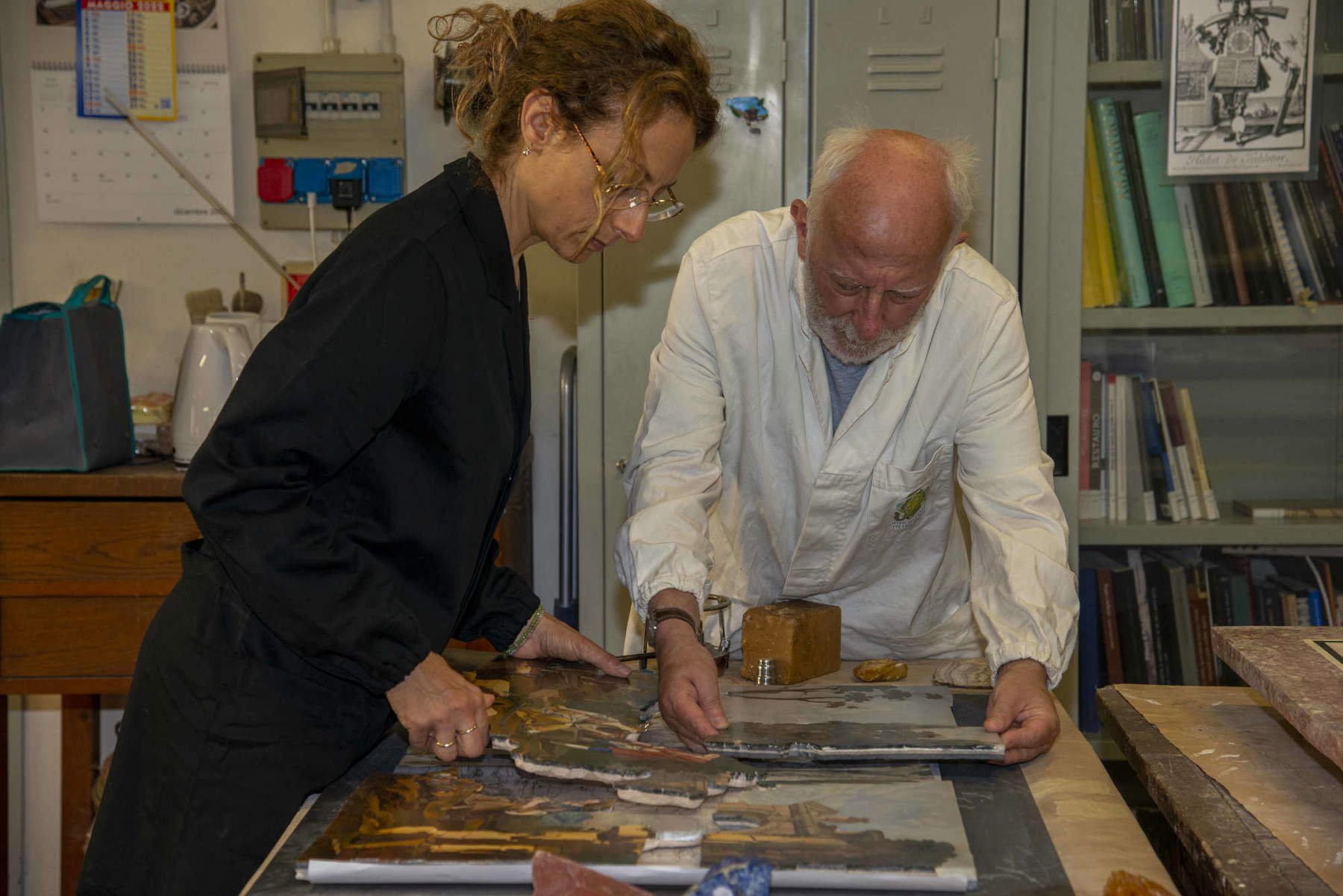
 A commesso
A commesso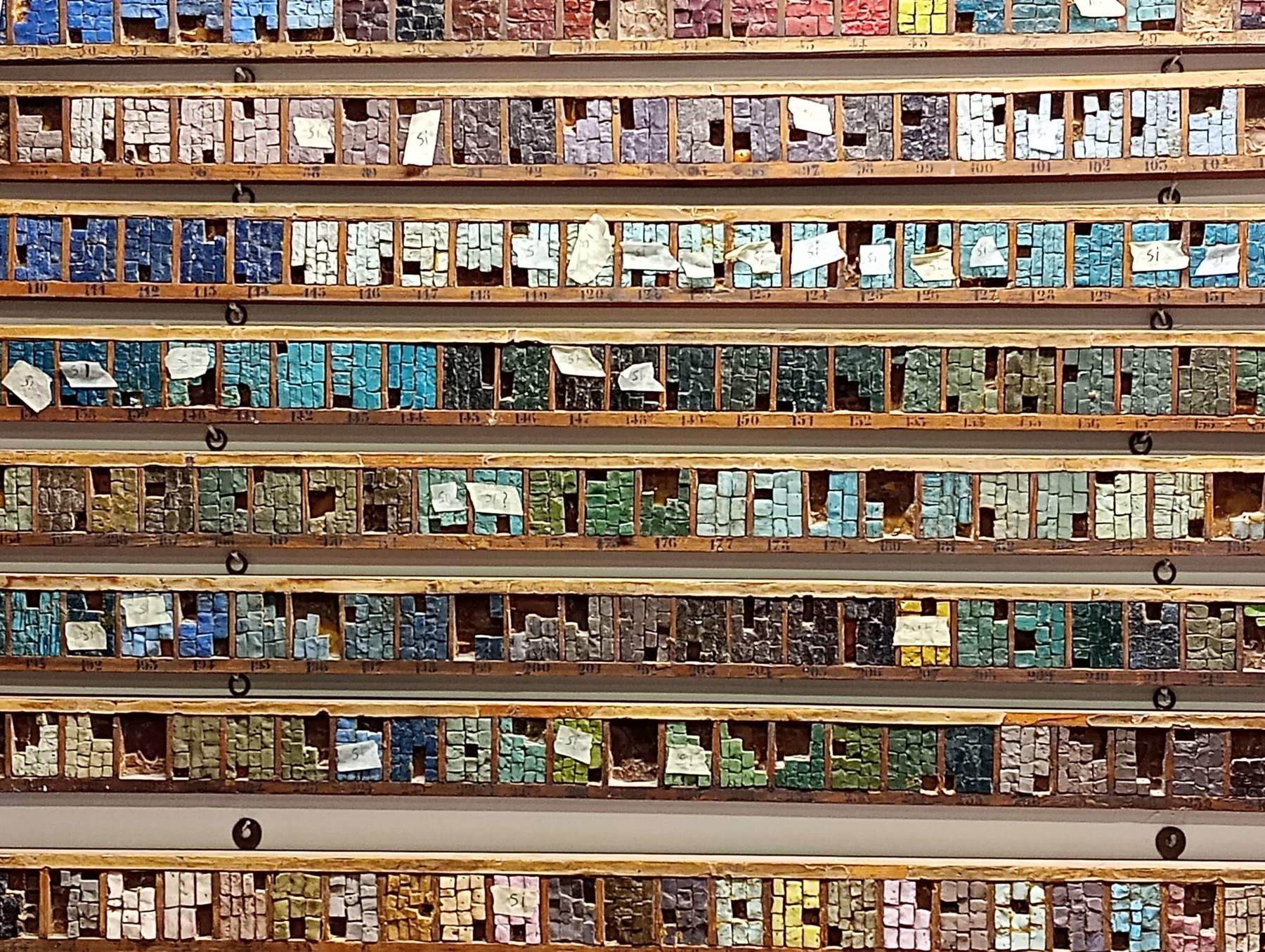
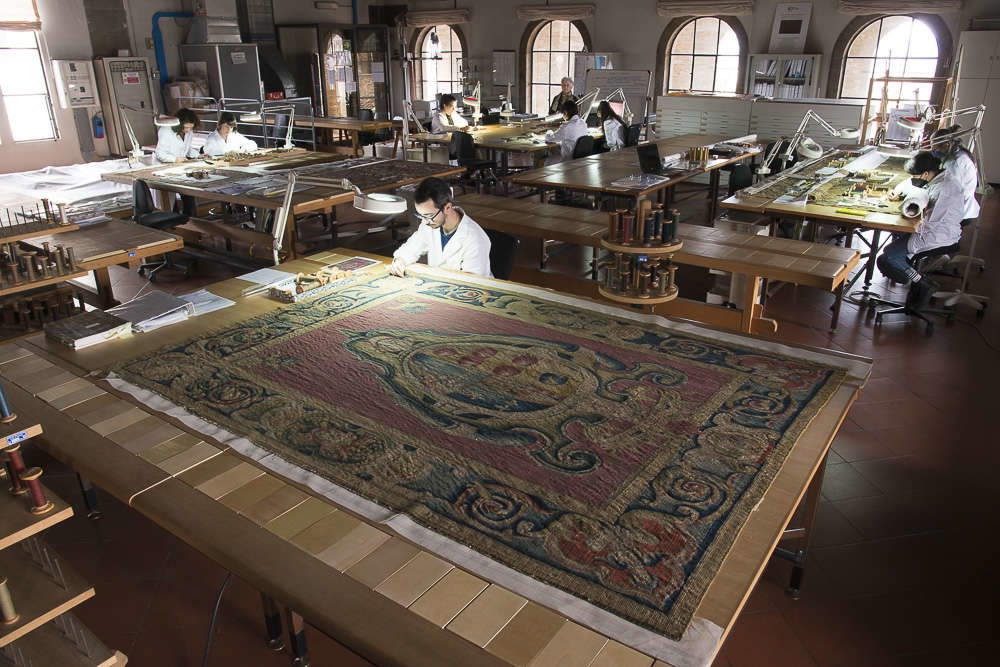
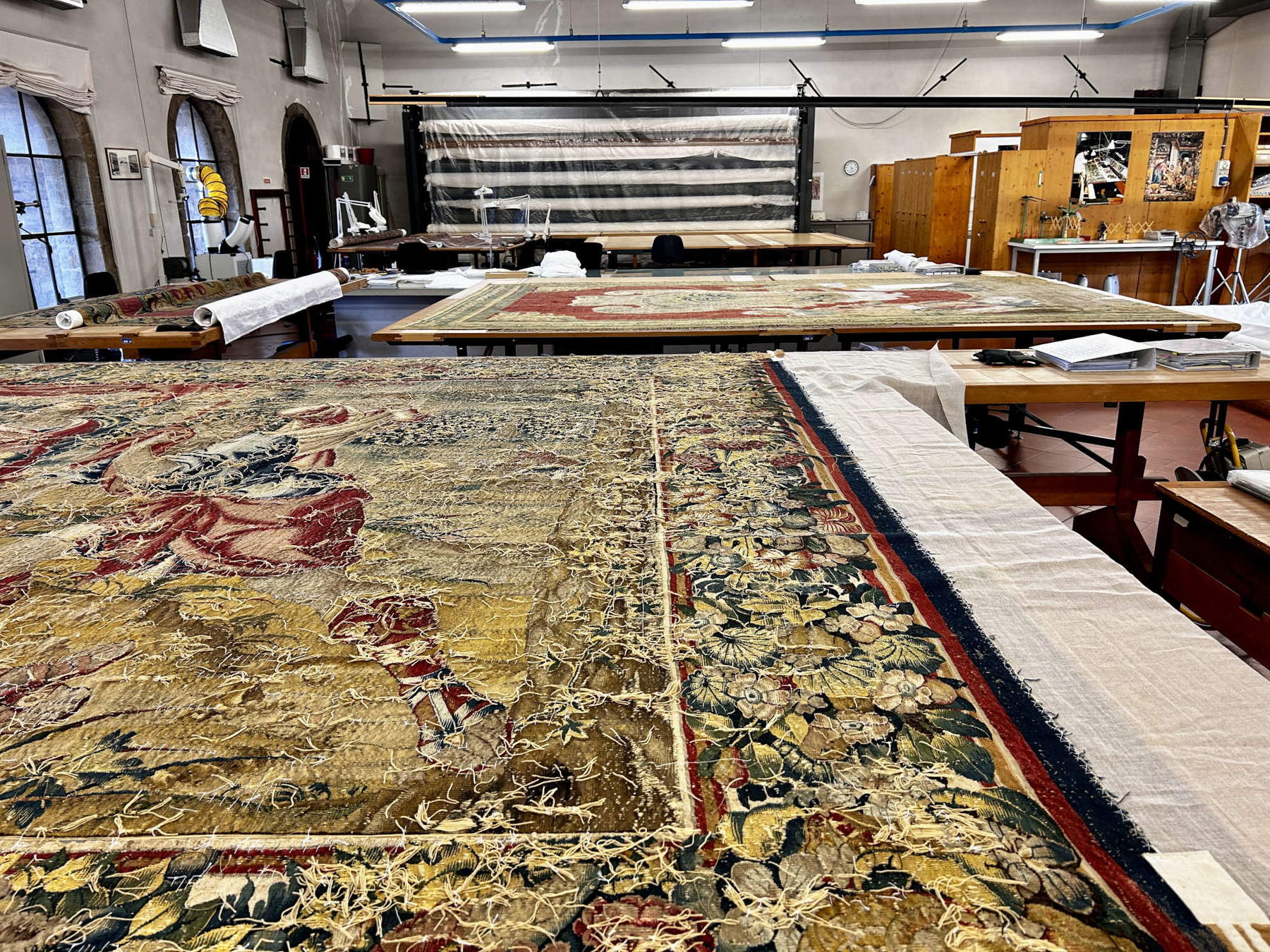 Tapestry
Tapestry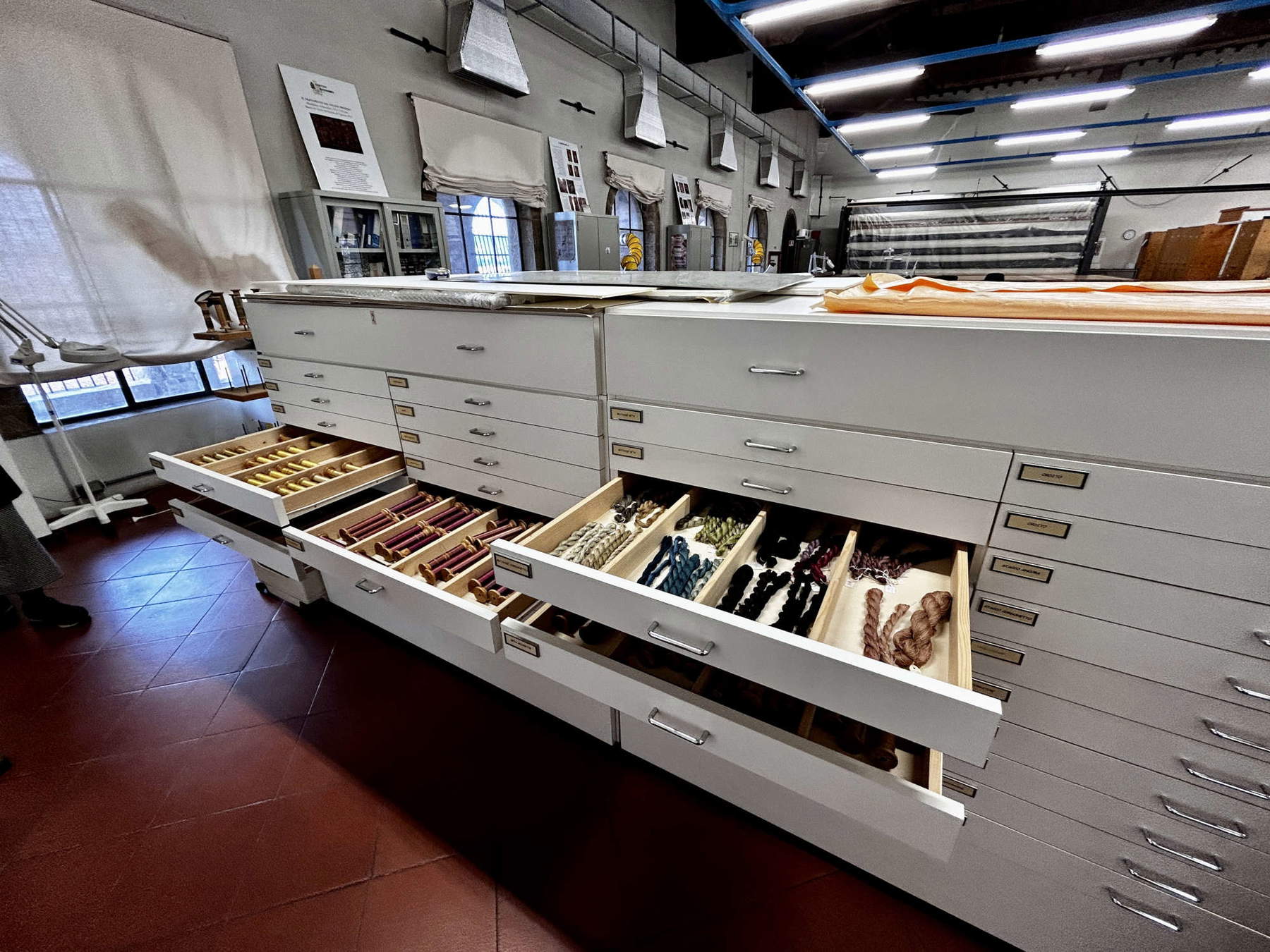 Tapestry
Tapestry
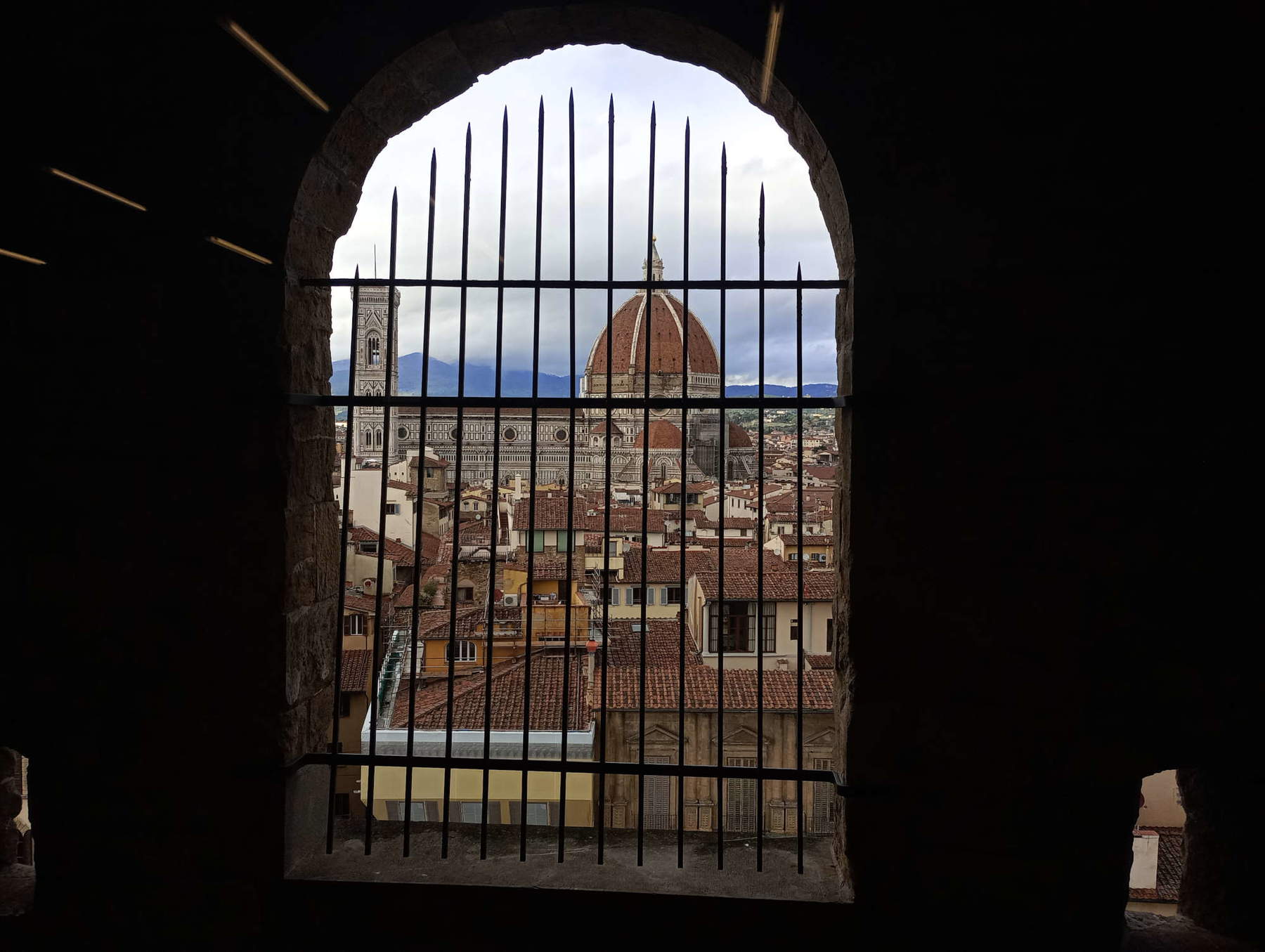
The question goes up, it comes without thinking, “but how do you get all this stuff up here?” The tapestry and carpet sector workshop is, indeed, located in a place that is hard to call convenient. We are in the Palazzo Vecchio, inside the Torre di Arnolfo: the laboratory is here. Fortunately they have installed it inside the Sala delle Bandiere, a spacious room and above all located at the base of the tower: the risk of having to walk all the way up to the top is averted, but access is still not the easiest because to get here there are no elevators and you have to climb up three steep, narrow staircases. Of course, along with the tourists who crowd the Palazzo Vecchio and have purchased a ticket to climb the tower. And to get the tapestries and carpets that are to be restored up here, there are typically two ways. One is easy to imagine: over the shoulder. It happens for the smaller, more manageable items, which do not risk being damaged as they climb the stairs (of course: they must be properly padded first). For bulkier or more delicate pieces, on the other hand, it is necessary to call a crane with a boom that can reach the height of the Palazzo Vecchio’s gallery, dismantle the grills that guard the large windows, and pass the tapestries through from outside. This is how it was done, for example, with the Stories of Joseph the Jew, a precious cycle of tapestries executed between 1545 and 1553 to designs by Bronzino and Pontormo and divided between the Palazzo Vecchio and the Quirinale. Indeed, it is because of them that the workshop is located here, explains Riccardo Gennaioli, who directs this area of restoration. One of the most complex, moreover.
“The work on the tapestries,” he explains, “is perhaps the one that requires the most hours of all: to do a restoration on a piece that is in less than optimal conservation condition does not take us less than two years, and we are talking about very fast timelines. This is because we are usually dealing with objects of enormous size and because the intervention techniques take time, despite the extraordinary dexterity with which our restorers are equipped.” In the center of the room, lying on tables, are several large tapestries with coats of arms: one of the largest bears in the center the coat of arms of Christina of Lorraine, wife of Ferdinand I de’ Medici. They are undergoing, Claudia Cirrincione explains, an integrative restoration: “When the warps and wefts, which are the basic structure of the tapestry, are missing, they are usually reintegrated, as much for the structure as for the figures. Reintegration is necessary because we are not in the presence of a painting that has a support or a pictorial film: here it is necessary to reintegrate the warp or weft where they are missing, since the tapestry is created by realizing both the textural structure and the figuration. Clearly, one chooses yarns of a very similar type compared to the original, compatible materials, which are prepared and dyed here in the workshop.” The restoration must be visible: it is necessary that one understands where the restoration part, the new portion, is inserted in relation to the original, but without any differences from the overall impression. Where reconstruction is not possible, for example where there are major gaps that restorers cannot reinvent, only the structure is reconstructed, for reasons of mechanical stability of the tapestry, without integrating the design, opting for a background color that is as neutral as possible. All this, Claudia Cirrincione assures us, with needle and thread.
The tapestries, like the paintings, sculptures and all the other objects that pass through the Opificio, are also subjected to cleaning: first through vacuum cleaners, with adjustable power (tests are carried out to figure out what power to use, what might be the right window for suction, and so on), after which, if the cleaning tests result in a favorable outcome, an immersion wash will take place. The tapestry will then be immersed in water “softened” with a mild detergent to remove deposits without damaging the fibers. “Washing takes a few hours,” the restorer explains, “usually a half day, although it must assume the help of many people. Drying, then, is a surprisingly easy process, in the sense that it is something that happens naturally, so without forcing the air circulation: the work is placed on top of horizontal nets, on tables, so that, over the course of a night and a day, it dries naturally. Indeed: drying must be slow, since wool does not like sudden changes in temperature or humidity.” Everything is monitored through contextual scientific investigations: so, in real time, water samples are taken and the professionals in the scientific laboratory, through special investigations, check the progress of the cleaning, the intensity of the dirt, the color of the water, the conductivity.
It was said that it is because of the Histories of Joseph the Jew that the Opificio’s tapestry laboratory is located in the Sala delle Bandiere in the Palazzo Vecchio: when their restoration had to begin, it was thought that it would be advisable to avoid subjecting the precious textiles to displacement, and so it was decided to set up the laboratory in that room, which had long been unused. And there it has remained since 1986. Would it be possible to move it to another location today? Perhaps yes. But certainly the new location would not have the same, wonderful view of the rooftops of Florence that we enjoy from the tower.
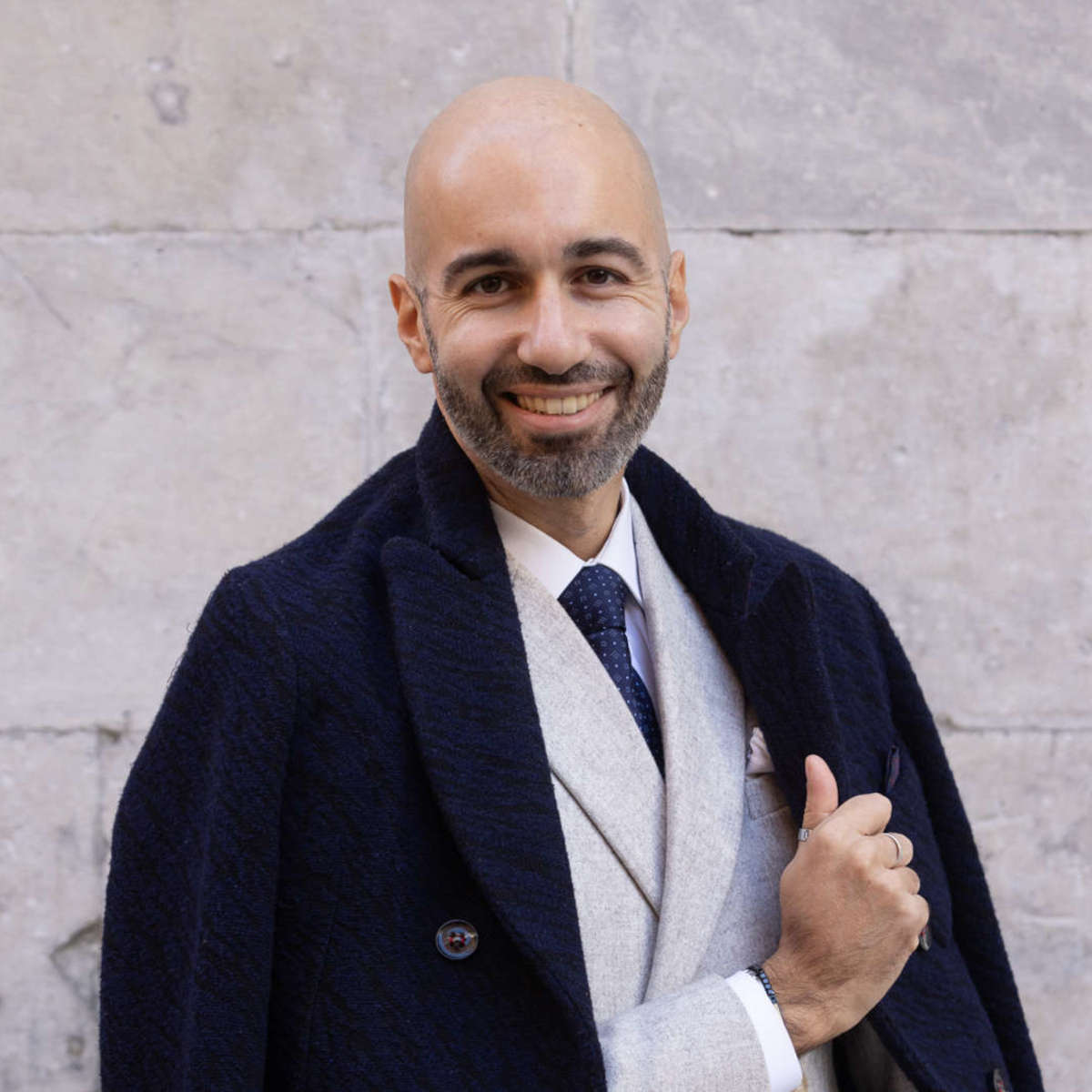
The author of this article: Federico Giannini
Nato a Massa nel 1986, si è laureato nel 2010 in Informatica Umanistica all’Università di Pisa. Nel 2009 ha iniziato a lavorare nel settore della comunicazione su web, con particolare riferimento alla comunicazione per i beni culturali. Nel 2017 ha fondato con Ilaria Baratta la rivista Finestre sull’Arte. Dalla fondazione è direttore responsabile della rivista. Nel 2025 ha scritto il libro Vero, Falso, Fake. Credenze, errori e falsità nel mondo dell'arte (Giunti editore). Collabora e ha collaborato con diverse riviste, tra cui Art e Dossier e Left, e per la televisione è stato autore del documentario Le mani dell’arte (Rai 5) ed è stato tra i presentatori del programma Dorian – L’arte non invecchia (Rai 5). Al suo attivo anche docenze in materia di giornalismo culturale all'Università di Genova e all'Ordine dei Giornalisti, inoltre partecipa regolarmente come relatore e moderatore su temi di arte e cultura a numerosi convegni (tra gli altri: Lu.Bec. Lucca Beni Culturali, Ro.Me Exhibition, Con-Vivere Festival, TTG Travel Experience).
Warning: the translation into English of the original Italian article was created using automatic tools. We undertake to review all articles, but we do not guarantee the total absence of inaccuracies in the translation due to the program. You can find the original by clicking on the ITA button. If you find any mistake,please contact us.